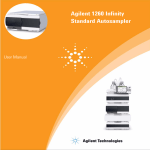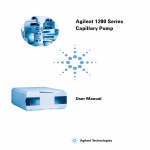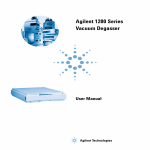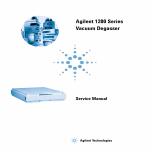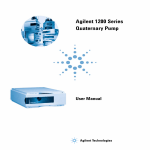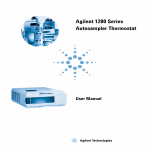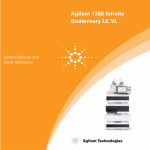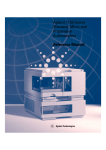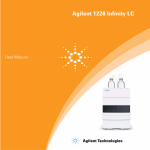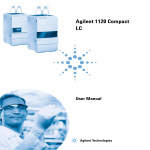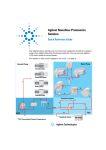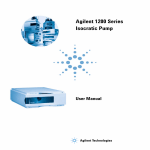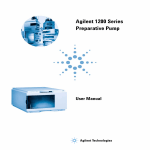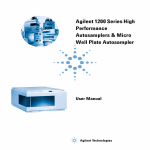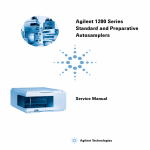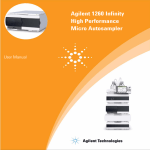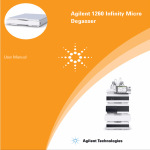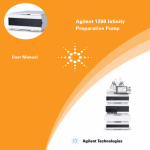Download G1329-90012 - Agilent Technologies
Transcript
Agilent 1200 Series
Standard and Preparative
Autosamplers
User Manual
Agilent 1200 Series Autosampler User Manual
Agilent Technologies
Notices
© Agilent Technologies, Inc. 2006,2008
Warranty
No part of this manual may be reproduced
in any form or by any means (including electronic storage and retrieval or translation
into a foreign language) without prior agreement and written consent from Agilent
Technologies, Inc. as governed by United
States and international copyright laws.
The material contained in this document is provided “as is,” and is subject to being changed, without notice,
in future editions. Further, to the maximum extent permitted by applicable
law, Agilent disclaims all warranties,
either express or implied, with regard
to this manual and any information
contained herein, including but not
limited to the implied warranties of
merchantability and fitness for a particular purpose. Agilent shall not be
liable for errors or for incidental or
consequential damages in connection
with the furnishing, use, or performance of this document or of any
information contained herein. Should
Agilent and the user have a separate
written agreement with warranty
terms covering the material in this
document that conflict with these
terms, the warranty terms in the separate agreement shall control.
Manual Part Number
G1329-90012
Edition
11/08
Printed in Germany
Agilent Technologies
Hewlett-Packard-Strasse 8
76337 Waldbronn
Research Use Only
Not for use in Diagnostic Procedures.
receive no greater than Restricted Rights as
defined in FAR 52.227-19(c)(1-2) (June
1987). U.S. Government users will receive
no greater than Limited Rights as defined in
FAR 52.227-14 (June 1987) or DFAR
252.227-7015 (b)(2) (November 1995), as
applicable in any technical data.
Safety Notices
CAUTION
A CAUTION notice denotes a
hazard. It calls attention to an
operating procedure, practice, or
the like that, if not correctly performed or adhered to, could
result in damage to the product
or loss of important data. Do not
proceed beyond a CAUTION
notice until the indicated conditions are fully understood and
met.
Technology Licenses
The hardware and/or software described in
this document are furnished under a license
and may be used or copied only in accordance with the terms of such license.
Restricted Rights Legend
If software is for use in the performance of a
U.S. Government prime contract or subcontract, Software is delivered and licensed as
“Commercial computer software” as
defined in DFAR 252.227-7014 (June 1995),
or as a “commercial item” as defined in FAR
2.101(a) or as “Restricted computer software” as defined in FAR 52.227-19 (June
1987) or any equivalent agency regulation
or contract clause. Use, duplication or disclosure of Software is subject to Agilent
Technologies’ standard commercial license
terms, and non-DOD Departments and
Agencies of the U.S. Government will
WA R N I N G
A WARNING notice denotes a
hazard. It calls attention to an
operating procedure, practice,
or the like that, if not correctly
performed or adhered to, could
result in personal injury or
death. Do not proceed beyond a
WARNING notice until the indicated conditions are fully understood and met.
Agilent 1200 Series Autosampler User Manual
Contents
Contents
1 Introduction to the Autosampler
7
Introduction to the Autosampler 8
Sampling Sequence 10
Sampling Unit 13
Transport Assembly 16
Early Maintenance Feedback (EMF) 18
Electrical Connections 19
Agilent 1200 Series Interfaces 21
2 Site Requirements and Specifications
23
Site Requirements 24
Physical Specifications 27
Performance Specifications 28
3 Installing the Autosampler
33
Unpacking the Autosampler 34
Optimizing the Stack Configuration 37
Installing the Autosampler 41
Installing the Thermostatted Autosampler
Flow Connections 48
Installing the Sample Tray 50
Transporting the Autosampler 51
4 Using the Autosampler
44
53
Solvent Information 54
Sample Trays 56
Choice of Vials and Caps 58
5 Optimizing Performance
61
Optimization for Lowest Carry-over 62
Fast Injection Cycle and Low Delay Volume
Precise Injection Volume 68
Agilent 1200 Series Autosampler User Manual
66
3
Contents
Choice of Rotor Seal
70
6 Troubleshooting and Diagnostics
71
Agilent Lab Monitor & Diagnostic Software 72
Overview of the Sampler’s Indicators and Test Functions
7 Maintenance
73
75
Introduction into Maintenance and Repair
Overview of Main Repair Procedures 80
Early Maintenance Feedback (EMF) 82
Maintenance Functions 84
Simple Repairs 85
8 Parts and Materials for Maintenance
76
105
Main Assemblies 106
Analytical-Head Assembly 108
Vial Trays 111
Standard Autosampler Accessory Kit G1329-68725 112
Preparative Autosampler Accessory Kit G2260-68705 113
Maintenance Kit G1313-68730 for G1329A 114
Maintenance Kit G1313-68719 for G1329B 115
Multi-Draw Kit G1313-6871 116
900 µl Injection Upgrade Kit G1363A for G1329A 117
External Tray G1313-60004 118
9 Identifying Cables
119
Cable Overview 120
Analog Cables 122
Remote Cables 125
BCD Cables 130
External Contact Cable 132
CAN/LAN Cables 133
Auxiliary Cable 134
RS-232 Cables 135
4
Agilent 1200 Series Autosampler User Manual
Contents
10 Appendix
137
General Safety Information 138
Lithium Batteries Information 142
Radio Interference 143
Sound Emission 144
Agilent Technologies on Internet 145
Agilent 1200 Series Autosampler User Manual
5
Contents
6
Agilent 1200 Series Autosampler User Manual
Agilent 1200 Series Autosampler User Manual
1
Introduction to the Autosampler
Introduction to the Autosampler
8
Sampling Sequence 10
Injection Sequence 11
Sampling Unit 13
Needle-Drive 14
Analytical head / preparative head
Injection-Valve 15
Transport Assembly
14
16
Early Maintenance Feedback (EMF)
Electrical Connections
18
19
Agilent 1200 Series Interfaces
21
Agilent Technologies
7
1
Introduction to the Autosampler
Introduction to the Autosampler
Introduction to the Autosampler
Three models of Agilent 1200 Series autosamplers are available; within this
introduction they will be referred to as the standard autosampler (G1329A),
the standard autosampler SL (G1329B) and the preparative autosampler
(G2260A). Unless otherwise stated all information in this section is valid for
all models.
The Agilent 1100 Series autosamplers and Agilent 1200 Series autosamplers
are designed for use with other modules of the Agilent 1200 Series LC system,
with the HP 1050 Series, or with other LC systems if adequate remote control
inputs and outputs are available. The autosamplerss are controlled from the
Agilent 1200 Series control module (G4208 A Instant Pilot) or from the Agilent
ChemStation for LC.
Three sample-rack sizes are available for the autosamplers. The standard
full-size rack holds 100 × 1.8 ml vials, while the two half-size racks provide
space for 40 × 1.8 ml vials and 15 × 6 ml vials respectively. Any two half-size
rack trays can be installed in the autosamplers simultaneously. A specially
designed sample-rack holding 100 × 1.8 ml vials is available for use with
thermostatted autosamplers. The half-size racks trays are not designed for an
optimal heat transfer when they are used with a thermostatted autosampler.
The autosamplers transport mechanism uses an X-Z-Theta movement to
optimize vial pick-up and return. Vials are picked up by the gripper arm, and
positioned below the sampling unit. The gripper transport mechanism and
sampling unit are driven by motors. Movement is monitored by optical sensors
and optical encoders to ensure correct operation. The metering device is
always flushed after injection to ensure minimum carry-over.
The standard analytical head device provides injection volumes from
0.1 – 100 µl. Two preparative head devices provide injection volumes from
0.1 – 900 µl. One head is limited by a system pressure of 200 bars, the other by
a system pressure of 400 bars. The G1329B autosampler SL uses an analytical
head providing injection volumes from 0.1 – 100 µl for pressures up to 600 bar
as used in rapid resolution systems.
The six-port injection valve unit (only 5 ports are used) is driven by a
high-speed hybrid stepper motor. During the sampling sequence, the valve unit
bypasses the autosamplers, and directly connects the flow from the pump to
8
Agilent 1200 Series Autosampler User Manual
Introduction to the Autosampler
Introduction to the Autosampler
1
the column. During injection and analysis, the valve unit directs the flow
through the autosamplers which ensures that the sample is injected
completely into the column, and that any sample residue is removed from the
metering unit and needle from before the next sampling sequence begins.
Different valves are available for the standard and preparative autosamplers.
Control of the vial temperature in the thermostatted autosampler is achieved
using an additional Agilent 1200 Series module; the ALS thermostat. Details of
this module are given in the Agilent 1200 Series thermostatted autosampler
Supplemental Manual.
6cVani^XVa]ZVY
HVbea^c\Jc^i
IgVchedgiVhhZbWan
6HBWdVgY
EdlZghjeean
K^VaIgVn
<g^eeZg6gb
CZZYaZhZVi
Hl^iX]^c\KVakZ
Figure 1
Overview of the Autosampler
Agilent 1200 Series Autosampler User Manual
9
1
Introduction to the Autosampler
Sampling Sequence
Sampling Sequence
The movements of the autosampler components during the sampling sequence
are monitored continuously by the autosampler processor. The processor
defines specific time windows and mechanical ranges for each movement. If a
specific step of the sampling sequence can’t be completed successfully, an
error message is generated.
Solvent is bypassed from the autosamplers by the injection valve during the
sampling sequence. The sample vial is selected by a gripper arm from a static
sample rack, or from external vial positions. The gripper arm places the
sample vial below the injection needle. The required volume of sample is
drawn into the sample loop by the metering device. Sample is applied to the
column when the injection valve returns to the mainpass position at the end of
the sampling sequence.
The sampling sequence occurs in the following order:
1 The injection valve switches to the bypass position.
2 The plunger of the metering device moves to the initialization position.
3 The gripper arm moves from the home position, and selects the vial. At the
same time, the needle lifts out of the seat.
4 The gripper arm places the vial below the needle.
5 The needle lowers into the vial.
6 The metering device draws the defined sample volume.
7 The needle lifts out of the vial.
8 If the automated needle wash is selected (see “Using the Automated Needle
Wash” on page 63), the gripper arm replaces the sample vial, positions the
wash vial below the needle, lowers the needle into the vial, then lifts the
needle out of the wash vial.
9 The gripper arm checks if the safety flap is in position.
10 The gripper arm replaces the vial, and returns to the home position.
Simultaneously, the needle lowers into the seat.
11 The injection valve switches to the mainpass position.
10
Agilent 1200 Series Autosampler User Manual
Introduction to the Autosampler
Sampling Sequence
1
Injection Sequence
Before the start of the injection sequence, and during an analysis, the injection
valve is in the mainpass position (Figure 2 on page 11). In this position, the
mobile phase flows through the autosamplers metering device, sample loop,
and needle, ensuring all parts in contact with sample are flushed during the
run, thus minimizing carry-over.
Figure 2
Mainpass Position
When the sample sequence begins, the valve unit switches to the bypass
position (Figure 3 on page 11). Solvent from the pump enters the valve unit at
port 1, and flows directly to the column through port 6.
Figure 3
Bypass Position
Agilent 1200 Series Autosampler User Manual
11
1
Introduction to the Autosampler
Sampling Sequence
Next, the needle is raised, and the vial is positioned below the needle. The
needle moves down into the vial, and the metering unit draws the sample into
the sample loop (Figure 4 on page 12).
Figure 4
Drawing the Sample
When the metering unit has drawn the required volume of sample into the
sample loop, the needle is raised, and the vial is replaced in the sample tray.
The needle is lowered into the needle seat, and the injection valve switches
back to the mainpass position, flushing the sample onto the column (Figure 5
on page 12).
Figure 5
12
Mainpass Position (Sample Injection)
Agilent 1200 Series Autosampler User Manual
Introduction to the Autosampler
Sampling Unit
1
Sampling Unit
The sampling unit comprises three main assemblies: needle drive, metering
device, and injection valve.
NOTE
The replacement sampling unit excludes the injection valve and metering head assemblies.
The sampling units for the standard and the preparative autosamplers are
different.
CZZYaZYg^kZ
BZiZg^c\YZk^XZ
>c_ZXi^dckVakZ
Figure 6
Autosampler Sampling Unit
Agilent 1200 Series Autosampler User Manual
13
1
Introduction to the Autosampler
Sampling Unit
Needle-Drive
The needle movement is driven by a stepper motor connected to the spindle
assembly by a toothed belt. The circular motion of the motor is converted to
linear motion by the drive nut on the spindle assembly. The upper and lower
needle positions are detected by reflection sensors on the sampling unit flex
board, while the needle-in-vial position is determined by counting the motor
steps from the upper needle-sensor position.
Analytical head / preparative head
The analytical head is driven by the stepper motor connected to the drive shaft
by a toothed belt. The drive nut on the spindle converts the circular movement
of the spindle to linear motion. The drive nut pushes the sapphire plunger
against the tension of the spring into the analytical head. The base of the
plunger sits on the large bearing of the drive nut, which ensures the plunger is
always centered. A ceramic ring guides the movement of the plunger in the
analytical head. The home position of the plunger is sensed by an infra-red
sensor on the sampling unit flex board, while the sample volume is determined
by counting the number of steps from the home position. The backward
movement of the plunger (driven by the spring) draws sample from the vial.
Table 1
14
Analytical Head Technical Data
Standard (100 µl
Standard (900 µl)
Preparative (900 µl)
Number of steps
15000
15000
15000
Volume resolution
7 nl/motor step
60 nl/motor step
60 nl/motor step
Maximum stroke
100 µl
900 µl
900 µl
Pressure limit
600 bar
200 bar
400 bar
Plunger material
Sapphire
Sapphire
Sapphire
Agilent 1200 Series Autosampler User Manual
Introduction to the Autosampler
Sampling Unit
1
Injection-Valve
The two-position 6-port injection valve is driven by a stepper motor. Only five
of the six ports are used (port 3 is not used). A lever/slider mechanism
transfers the movement of the stepper motor to the injection valve. Two
microswitches monitor switching of the valve (bypass and mainpass end
positions).
No valve adjustments are required after replacing internal components.
Table 2
Injection-Valve Technical Data
Standard
Preparative MBB™
Autosampler SL
Motor type
4 V, 1.2 A stepper motor
4 V, 1.2 A stepper motor
4 V, 1.2 A stepper motor
Seal material
Vespel™ (Tefzel™
available)
PEEK
PEEK
Stator material
Ceramic/PEEK
PEEK
None
Number of ports
6
6
6
Switching time
< 150 ms
< 150 ms
< 150 ms
Agilent 1200 Series Autosampler User Manual
15
1
Introduction to the Autosampler
Transport Assembly
Transport Assembly
The transport unit comprises an X-axis slide (left-right motion), a Z-axis arm
(up-down motion), and a gripper assembly (rotation and vial-gripping).
Mbdidg
I]ZiVbdidg
<g^eeZgbdidg
MVm^h
<g^eeZg
I]ZiVVm^h
OVm^h
Obdidgcdi^ck^Zl
;aZmWdVgY
Figure 7
Transport Assembly
The transport assembly uses four stepper motors driven in closed-loop mode
for accurate positioning of the gripper assembly for sample-vial transport. The
rotational movement of the motors is converted to linear motion (X- and
Z-axes) by toothed belts connected to the drive spindles. The rotation (theta
axes) of the gripper assembly is transferred from the motor by a toothed belt
and series of gears. The opening and closing of the gripper fingers are driven
by a stepper motor linked by a toothed belt to the planetary gearing inside the
gripper assembly.
16
Agilent 1200 Series Autosampler User Manual
Introduction to the Autosampler
Transport Assembly
1
The stepper motor positions are determined by the optical encoders mounted
onto the stepper-motor housing. The encoders monitor the position of the
motors continually, and correct for position errors automatically (e.g. if the
gripper is accidentally moved out of position when loading vials into the vial
tray). The initialization positions of the moving components are sensed by
reflection sensors mounted on the flex board. These positions are used by the
processor to calculate the actual motor position. An additional six reflection
sensors for tray recognition are mounted on the flex board at the front of the
assembly.
Agilent 1200 Series Autosampler User Manual
17
1
Introduction to the Autosampler
Early Maintenance Feedback (EMF)
Early Maintenance Feedback (EMF)
The early maintenance feedback (EMF) feature monitors the usage of specific
components in the instrument, and provides feedback when the user-setable
limits have been exceeded. The visual feedback in the user interface provides
an indication that maintenance procedures should be scheduled.
For details on EMF counters and how to use them, see “Early Maintenance
Feedback (EMF)” on page 82.
18
Agilent 1200 Series Autosampler User Manual
1
Introduction to the Autosampler
Electrical Connections
Electrical Connections
• The GPIB connector is used to connect the module with a computer. The
address and control switch module next to the GPIB connector determines
the GPIB address of your module. The switches are preset to a default
address and is recognized once after power is switched ON.
• The CAN bus is a serial bus with high speed data transfer. The two
connectors for the CAN bus are used for internal Agilent 1200 Series
module data transfer and synchronization.
• One analog output provides signals for integrators or data handling
systems.
• The interface board slot is used for external contacts and BCD bottle
number output or LAN connections.
• The REMOTE connector may be used in combination with other analytical
instruments from Agilent Technologies if you want to use features such as
start, stop, common shut down, prepare, and so on.
• With the appropriate software, the RS-232C connector may be used to
control the module from a computer through a RS-232C connection. This
connector is activated and can be configured with the configuration switch.
See your software documentation for further information.
• The power input socket accepts a line voltage of 100 – 240 volts AC ± 10%
with a line frequency of 50 or 60 Hz. Maximum power consumption is
300 VA. There is no voltage selector on your module because the power
supply has wide-ranging capability. There are no externally accessible
fuses, because automatic electronic fuses are implemented in the power
supply. The security lever at the power input socket prevents the module
cover from being taken off when line power is still connected.
NOTE
Never use cables other than the ones supplied by Agilent Technologies to ensure proper
functionality and compliance with safety or EMC regulations.
Agilent 1200 Series Autosampler User Manual
19
1
Introduction to the Autosampler
Electrical Connections
GZaVnXdciVXih
K^VacjbWZgdjieji
GZbdiZ
GH'('8
86C"Wjh
<E>7
8dccZXi^dc
6AH"I]ZgbdhiVi
<&((%7I]ZgbdhiVi
dei^dcVa
Figure 8
20
Autosampler (plus Thermostat) Electrical Connections
Agilent 1200 Series Autosampler User Manual
1
Introduction to the Autosampler
Agilent 1200 Series Interfaces
Agilent 1200 Series Interfaces
The Agilent 1200 Series modules provide the following interfaces:
Table 3
Agilent 1200 Series Interfaces
Interface Type
Pumps
Autosampler
DA Detector
MW Detector
FL Detector
VW Detector
RI Detector
Thermostatted Vacuum
Column
Degasser
Compartment
CAN
Yes
Yes
Yes
Yes
Yes
No
GPIB
Yes
Yes
Yes
Yes
Yes
No
RS-232C
Yes
Yes
Yes
Yes
Yes
No
APG Remote
Yes
Yes
Yes
Yes
Yes
Yes
Analog
Yes
No
2×
1×
No
Yes1
Interface board2
Yes
Yes
Yes
Yes
No
No
1
The vacuum degasser will have a special connector for specific use. For details, see the degasser manual.
2
The interface board slot (not common to all modules) provides specific interfacing needs (external contacts, BCD, LAN and so on).
Agilent 1200 Series Autosampler User Manual
21
1
22
Introduction to the Autosampler
Agilent 1200 Series Interfaces
Agilent 1200 Series Autosampler User Manual
Agilent 1200 Series Autosampler User Manual
2
Site Requirements and Specifications
Site Requirements 24
Power Consideration
Power Cords 25
Bench Space 26
Environment 26
Physical Specifications
24
27
Performance Specifications
28
Agilent Technologies
23
2
Site Requirements and Specifications
Site Requirements
Site Requirements
A suitable environment is important to ensure optimum performance of the
instrument.
Power Consideration
The autosampler power supply has wide-ranging capability (see Table 4 on
page 27). Consequently there is no voltage selector in the rear of the
autosampler. There are also no externally accessible fuses, because automatic
electronic fuses are implemented in the power supply.
The thermostatted autosampler comprises two modules, the standard or
preparative autosampler and the thermostat (G1330B). Both modules have a
separate power supply and a power plug for the line connections. The two
modules are connected by a control cable and both are turned on by the
autosampler module.
WA R N I N G
Damaged electronics
Disconnecting or reconnecting the sampler to thermostat cable when the power
cords are connected to either of the two modules will damage the electronics of the
modules.
➔ Make sure the power cords are unplugged before disconnecting or reconnecting the
sampler to thermostat cable.
WA R N I N G
Incorrect line voltage at the instrument
Shock hazard or damage of your instrumentation can result, if the devices are
connected to a line voltage higher than specified.
➔ Connect your instrument to the specified line voltage.
24
Agilent 1200 Series Autosampler User Manual
2
Site Requirements and Specifications
Site Requirements
CAUTION
Unaccessable power plug.
In case of emergency it must be possible to disconnect the instrument from the power
line at any time.
➔ Make sure the power connector of the instrument can be easily reached and
unplugged.
➔ Provide sufficient space behind the power socket of the instrument to unplug the
cable.
Power Cords
Different power cords are offered as options with the module. The female end
of all power cords is identical. It plugs into the power-input socket at the rear
of the module. The male end of each power cord is different and designed to
match the wall socket of a particular country or region.
WA R N I N G
The absence of ground connection and the use of an unspecified power cord can
lead to electric shock or short circuit.
Electric Shock
➔ Never operate your instrumentation from a power outlet that has no ground
connection.
➔ Never use a power cord other than the Agilent Technologies power cord designed
for your region.
WA R N I N G
Use of unsupplied cables
Using cables not supplied by Agilent Technologies can lead to damage of the
electronic components or personal injury.
➔ Never use cables other than the ones supplied by Agilent Technologies to ensure
proper functionality and compliance with safety or EMC regulations.
Agilent 1200 Series Autosampler User Manual
25
2
Site Requirements and Specifications
Site Requirements
Bench Space
The autosampler dimensions and weight (see Table 4 on page 27) allow the
instrument to be placed on almost any laboratory bench. The instrument
requires an additional 2.5 cm (1.0 inch) of space on either side, and
approximately 8 cm (3.1 inches) at the rear for the circulation of air, and room
for electrical connections. Ensure the autosampler is installed in a horizontal
position.
The thermostatted autosampler dimensions and weight allow the instrument
to be placed on almost any laboratory bench. The instrument requires an
additional 25 cm (10 inches) of space on either side for the circulation of air,
and approximately 8 cm (3.1 inches) at the rear for electrical connections.
Ensure the autosampler is installed in a level position.
If a complete Agilent 1200 Series system is to be installed on the bench, make
sure that the bench is designed to carry the weight of all the modules. For a
complete system including the thermostatted autosampler it is recommended
to position the modules in two stacks, see “Optimizing the Stack
Configuration” on page 37. Make sure that in this configuration there is 25 cm
(10 inches) space on either side of the thermostatted autosampler for the
circulation of air.
Environment
Your module will work within specifications at ambient temperatures and
relative humidity as described in Table 4 on page 27.
CAUTION
Condensation within the module
Condensation will damage the system electronics.
➔ Do not store, ship or use your module under conditions where temperature
fluctuations could cause condensation within the module.
➔ If your module was shipped in cold weather, leave it in its box and allow it to warm
slowly to room temperature to avoid condensation.
26
Agilent 1200 Series Autosampler User Manual
2
Site Requirements and Specifications
Physical Specifications
Physical Specifications
Table 4
WA R N I N G
Physical Specifications
Type
Specification
Comments
Weight
14.2 kg (32 lbs)
Dimensions
(width × depth × height)
200 × 345 × 435 mm (8 × 13.5 × 17
inches)
Line voltage
100 – 240 VAC, ± 10%
Line frequency
50 or 60 Hz, ± 5%
Power consumption
300 VA / 200 W / 683 BTU
Maximum
Ambient operating
temperature
0–55 °C (32–131 °F)
See warning “” on page 27
Ambient non-operating
temperature
-40–70 °C (-4–158 °F)
Humidity
< 95%, at 25–40 °C (77–104 °F)
Operating Altitude
Up to 2000 m (6500 ft)
Non-operating altitude
Up to 4600 m (14950 ft)
For storing the module
Safety standards: IEC, CSA,
UL
Installation Category II, Pollution
Degree 2
For indoor use only. Research
Use Only. Not for use in
Diagnostic Procedures.
Wide-ranging capability
Non-condensing
Hot rear panel
Using the autosampler at high environmental temperatures may cause the rear
panel to become hot.
➔ Do not use the autosampler at environmental temperatures higher than 50 °C
(122 °F)
Agilent 1200 Series Autosampler User Manual
27
2
Site Requirements and Specifications
Performance Specifications
Performance Specifications
Table 5
Performance Specifications Agilent 1200 Series Autosampler (G1329A). Valid
when standard 100 µl metering head installed.
Type
Specification
Pressure
Operating range 0 – 40 MPa (0 – 400 bar, 0 – 5900 psi)
GLP features
Early maintenance feedback (EMF), electronic records of
maintenance and errors
Communications
Controller-area network (CAN). GPIB (IEEE-448), RS232C,
APG-remote standard, optional four external contact closures and
BCD vial number output
Safety features
Leak detection and safe leak handling, low voltages in maintenance
areas, error detection and display
Injection range
0.1 – 100 µl in 0.1 µl increments Up to 1500 µl with multiple draw
(hardware modification required)
Replicate injections
1 – 99 from one vial
Precision
< 0.25% RSD from 5 – 100 µl, < 1% RSD 1 – 5 µl
variable volume
Minimum sample volume
1 µl from 5 µl sample in 100 µl microvial, or 1 µl from 10 µl sample in
300 µl microvial
Carryover
Typically < 0.1%, < 0.05% with external needle cleaning
Sample viscosity range
0.2 – 50 cp
Replicate injections per vial 1 – 99
28
Sample capacity
100 × 2-ml vials in 1 tray
40 × 2-ml vials in ½ tray
15 × 6-ml vials in ½ tray (Agilent vials only)
Injection cycle time
Typically 50 s depending on draw speed and injection volume
Agilent 1200 Series Autosampler User Manual
Site Requirements and Specifications
Performance Specifications
Table 6
2
Performance Specifications Agilent 1200 Series standard autosampler
(G1329A). Valid when standard 900 µl metering head installed.
Type
Specification
Pressure
Operating range 0 – 20 MPa (0 – 200 bar, 0 – 2950 psi)
GLP features
Early maintenance feedback (EMF), electronic records of
maintenance and errors
Communications
Controller-area network (CAN). GPIB (IEEE-448), RS232C,
APG-remote standard, optional four external contact closures and
BCD vial number output
Safety features
Leak detection and safe leak handling, low voltages in maintenance
areas, error detection and display
Injection range
0.1 – 900 µl in 0.1 µl increments (recommended 1 µl increments) Up
to 1800 µl with multiple draw (hardware modification required)
Replicate injections
1 – 99 from one vial
Precision
Typically < 0.5% RSD of peak areas from 5 – 2000 µl, Typically
< 1% RSD of peak areas from 2000 – 5000 µl, Typically < 3% RSD of
peak areas from 1 – 5 µl
Minimum sample volume
1 µl from 5 µl sample in 100 µl microvial, or 1 µl from 10 µl sample in
300 µl microvial
Carryover
Typically < 0.1%, < 0.05% with external needle cleaning
Sample viscosity range
0.2 – 50 cp
Sample capacity
100 × 2-ml vials in 1 tray
40 × 2-ml vials in ½ tray
15 × 6-ml vials in ½ tray (Agilent vials only)
Injection cycle time
50 s for draw speed 200 µl/min, ejection speed 200 µl/min, injection
volume 5 µl
Agilent 1200 Series Autosampler User Manual
29
2
Site Requirements and Specifications
Performance Specifications
Table 7
30
Performance Specifications Agilent 1200 Series standard autosampler SL
(G1329B).
Type
Specification
Pressure
Operating range 0 – 60 MPa (0 – 600 bar, 0 – 8850 psi)
GLP features
Early maintenance feedback (EMF), electronic records of
maintenance and errors
Communications
Controller-area network (CAN). GPIB (IEEE-448), RS232C,
APG-remote standard, optional four external contact closures and
BCD vial number output
Safety features
Leak detection and safe leak handling, low voltages in maintenance
areas, error detection and display
Injection range
0.1 – 100 µl in 0.1 µl increments (recommended 1 µl increments) Up
to 15 00 µl with multiple draw (hardware modification required)
Replicate injections
1 – 99 from one vial
Precision
Typically < 0.25% RSD of peak areas from 5 – 100 µl, Typically
< 1% RSD of peak areas from 1 – 5 µl,
Minimum sample volume
1 µl from 5 µl sample in 100 µl microvial, or 1 µl from 10 µl sample in
300 µl microvial
Carryover
Typically < 0.1%, < 0.05% with external needle cleaning
Sample viscosity range
0.2 – 50 cp
Sample capacity
100 × 2-ml vials in 1 tray
40 × 2-ml vials in ½ tray
15 × 6-ml vials in ½ tray (Agilent vials only)
Injection cycle time
50 s for draw speed 200 µl/min, ejection speed 200 µl/min, injection
volume 5 µl
Agilent 1200 Series Autosampler User Manual
Site Requirements and Specifications
Performance Specifications
Table 8
2
Performance Specifications Agilent 1200 Series Preparative Autosampler
(G2260A)
Type
Specification
Pressure
Operating range 0 – 40 MPa (0 – 400 bar, 0 – 5800psi)
GLP features
Early maintenance feedback (EMF), electronic records of
maintenance and errors
Communications
Controller-area network (CAN). GPIB (IEEE-448), RS232C,
APG-remote standard, optional four external contact closures and
BCD vial number output
Safety features
Leak detection and safe leak handling, low voltages in maintenance
areas, error detection and display
Injection range
0.1 – 900 µl in 0.1 µl increments (recommended 1 µl increments)
Up to 1800 µl with multiple draw (hardware modification required)
Up to 5000 µl with multiple draw (hardware modification required)
Replicate injections
1 – 99 from one vial
Precision
Typically < 0.5% RSD of peak areas from 5 – 2000 µl, Typically
< 1% RSD of peak areas from 2000 – 5000 µl, Typically < 3% RSD of
peak areas from 1 – 5 µl
Minimum sample volume
1 µl from 5 µl sample in 100 µl microvial, or 1 µl from 10 µl sample in
300 µl microvial
Sample viscosity range
0.2 – 50 cp
Sample capacity
100 × 2-ml vials in 1 tray
15 × 6-ml vials in ½ tray (Agilent vials only)
Injection cycle time
Typically 50 s, depending on draw speed and injection volume
Agilent 1200 Series Autosampler User Manual
31
2
32
Site Requirements and Specifications
Performance Specifications
Agilent 1200 Series Autosampler User Manual
Agilent 1200 Series Autosampler User Manual
3
Installing the Autosampler
Unpacking the Autosampler 34
Damaged Packaging 34
Delivery Checklist 34
Optimizing the Stack Configuration
Installing the Autosampler
37
41
Installing the Thermostatted Autosampler
Flow Connections
44
48
Installing the Sample Tray
50
Transporting the Autosampler
51
Agilent Technologies
33
3
Installing the Autosampler
Unpacking the Autosampler
Unpacking the Autosampler
CAUTION
Mechanical damage of the autosampler
If the transport assembly is not parked, the autosampler could be damaged due to
excessive shock of the shipping container during transport.
➔ Always park the transport assembly before shipment (see “Transporting the
Autosampler” on page 51).
Damaged Packaging
Upon receipt of your autosampler, inspect the shipping containers for any
signs of damage. If the containers or cushioning material are damaged, save
them until the contents have been checked for completeness and the
autosampler has been checked mechanically and electrically. If the shipping
container or cushioning material is damaged, notify the carrier and save the
shipping material for the carriers inspection.
Delivery Checklist
Ensure all parts and materials have been delivered with the autosampler. The
instrument box contains the instrument and an Accessory kit. A separate box
contains the reference manual and the power cable.
In Table 9 on page 35 and Table 10 on page 36 are listed the content of each
accessory kit.
Please report missing or damaged parts to your local Agilent Technologies
sales and service office.
34
Agilent 1200 Series Autosampler User Manual
Installing the Autosampler
Unpacking the Autosampler
Table 9
G1329A/G1329B - Standard Autosampler Accessory Kit Contents G1329-68725
Description
Part Number
Tubing assembly
5063-6527
CAN cable, 1 m long
5181-1519
Screw cap vials, clear 100/pk
5182-0714
Blue screw caps 100/pk
5182-0717
Label halftray
5989-3890
Vial instruction sheet
no PN
Wrenches 1/4 - 5/16 inch
8710-0510
Rheotool socket wrench 1/4 inch
8710-2391
Hex key 4 mm, 15 cm long, T-handle
8710-2392
Hex key 9/64 inch, 15 cm long, T- handle
8710-2394
Hex key 2.5 mm, 15 cm long, straight handle
8710-2412
Finger caps (x3)1
5063-6506
Front door cooled autosampler
G1329-40301
Air channel adapter
G1329-43200
Cover insulation
no PN
Capillary 0.17 mm, 900 mm
G1329-87300
Capillary heat exchanger
01090-87306
Note for Agilent 1200 Series Autosampler door upgrade
no PN
1
3
Reorder gives pack of 15
Agilent 1200 Series Autosampler User Manual
35
3
Installing the Autosampler
Unpacking the Autosampler
Table 10
36
G2260A - Preparative Autosampler Accessory Kit Contents G2260-68705
Description
Part Number
Tubing assembly
5063-6527
Filter promo kit
5064-8240
CAN cable, 1 m long
5181-1519
Screw cap vials, clear 100/pk
5182-0714
Blue screw caps 100/pk
5182-0717
Label halftray
5989-3890
Wrenches 1/4 - 5/16 inch
8710-0510
Rheotool socket wrench 1/4 inch
8710-2391
Hex key 4 mm, 15 cm long, T-handle
8710-2392
Hex key 9/64 inch, 15 cm long, T- handle
8710-2394
Hex key 2.5 mm, 15 cm long, straight handle
8710-2412
Finger caps x3 (reorder gives pack of 15)
5063-6506
Front door cooled autosampler
G1329-40301
Air channel adapter
G1329-43200
Tray for 15 x 6 ml vials (x2)
G1313-44513
Union, loop extension
5022-2133
Seat extension capillary (500 µl)
G1313-87307
Seat extension capillary (1500 µl)
G1313-87308
Sampler - Column capillary
G2260-87300
Agilent 1200 Series Autosampler User Manual
Installing the Autosampler
Optimizing the Stack Configuration
3
Optimizing the Stack Configuration
If your autosampler is part of a system, you can ensure optimum performance
by installing the autosampler in the stack in the position shown in Figure 9 on
page 37 and Figure 10 on page 38. Figure 11 on page 39 and Figure 12 on
page 40 show the configuration recommended for a thermostatted
autosampler. These configurations optimize the system flow path, ensuring
minimum delay volume.
HdakZciXVW^cZi
KVXjjbYZ\VhhZg
Ejbe
>chiVciE^adi
6jidhVbeaZgdg
EgZeVgVi^kZ
6jidhVbeaZg
8dajbcXdbeVgibZci
9ZiZXidg
Figure 9
Recommended Stack Configuration for an Autosampler (Front View)
Agilent 1200 Series Autosampler User Manual
37
3
Installing the Autosampler
Optimizing the Stack Configuration
GZbdiZXVWaZ
68edlZg
86C7jhXVWaZid
>chiVciE^adi
86C7jhXVWaZ
A6CidA8
8]ZbHiVi^dc
6cVad\h^\cVaid
gZXdgYZg
Figure 10
38
Recommended Stack Configuration for an Autosampler (Rear View)
Agilent 1200 Series Autosampler User Manual
Installing the Autosampler
Optimizing the Stack Configuration
3
>chiVciE^adi
9ZiZXidg
8dajbc
8dbeVgibZci
HdakZci
8VW^cZi
HiVcYVgYdg
EgZeVgVi^kZ
6jidhVbeaZg
9Z\VhhZg
Ejbe
6AHI]ZgbdhiVi
Figure 11
Recommended Stack Configuration for a thermostatted ALS (Front View)
Agilent 1200 Series Autosampler User Manual
39
3
Installing the Autosampler
Optimizing the Stack Configuration
A6CidA88]ZbHiVi^dc
6cVad\h^\cVaidgZXdgYZg
6jidhVbeaZg"I]ZgbdhiViXVWaZ
GZbdiZXVWaZ
6cVad\h^\cVa
idgZXdgYZg
86CWjhXVWaZ
Figure 12
40
Recommended Stack Configuration for a thermostatted ALS (Rear View)
Agilent 1200 Series Autosampler User Manual
Installing the Autosampler
Installing the Autosampler
3
Installing the Autosampler
Parts required
Preparations
WA R N I N G
#
Description
1
Sampler
1
Power cord, for the other cables see below and “Cable Overview” on page 120
1
Control Software (ChemStation, EZChrom, OL, etc.) and/or Control Module G1323B
•
•
•
Locate bench space
Provide power connection
Unpack the Sampler
Module is partially energized when switched off, as long as the power cord is
plugged in.
Risk of stroke and other personal injury. Repair work at the module can lead to
personal injuries, e. g. shock hazard, when the module cover is opened and the
instrument is connected to power.
➔ Never perform any adjustment, maintenance or repair of the module with the top
cover removed and with the power cord plugged in.
➔ The security lever at the power input socket prevents that the module cover is taken
off when line power is still connected. Never plug the power line back in when cover
is removed.
WA R N I N G
Personal injury
To avoid personal injury, keep fingers away from the needle area during autosampler
operation.
➔ Do not bend the safety flap away from its position, or attempt to remove the safety
cover (see Figure 13 on page 42).
➔ Do not attempt to insert or remove a vial from the gripper when the gripper is
positioned below the needle.
Agilent 1200 Series Autosampler User Manual
41
3
Installing the Autosampler
Installing the Autosampler
CAUTION
“Defective on arrival” problems
If there are signs of damage to the autosampler, please do not attempt to install the
autosampler. Inspection by Agilent is required to evaluate if the instrument is in good
condition or damaged.
➔ Notify your Agilent sales and service office about the damage.
➔ An Agilent service representative will inspect the instrument at your site and
initiate appropriate actions.
1 Install the LAN interface board in the sampler (if required).
HV[ZinXdkZg
HV[Zin[aVe
Figure 13
Safety Flap
2 Remove the adhesive tape which covers the front door.
3 Remove the front door and remove the transport protection foam.
4 Place the Autosampler on the bench or in the stack as recommended in
“Optimizing the Stack Configuration” on page 37.
5 Ensure the power switch at the front of the Autosampler is OFF.
6 Connect the power cable to the power connector at the rear of the sampler.
7 Connect the CAN cable to the other Agilent 1200 Series modules.
8 If an Agilent Chemstation is the controller, connect either
• The GPIB cable to the detector
42
Agilent 1200 Series Autosampler User Manual
Installing the Autosampler
Installing the Autosampler
3
• The LAN connector to the LAN interface
9 Connect the APG remote cable (optional) for non Agilent 1200 Series
instruments.
10 Turn ON power by pushing the button at the lower left hand side of the
sampler.
K^VacjbWZgdjieji
86CXVWaZ
idegZk^djhbdYjaZ
GZbdiZ
GH'('8
86C"Wjh
GZaVnXdciVXih
<E>7
Figure 14
Cable Connections
NOTE
If the front cover is not installed the autosampler is in a not ready condition and operation is
inhibited.
NOTE
The sampler is turned ON when the line power switch is pressed and the green indicator
lamp is illuminated. The detector is turned OFF when the line power switch is protruding
and the green light is OFF.
Agilent 1200 Series Autosampler User Manual
43
3
Installing the Autosampler
Installing the Thermostatted Autosampler
Installing the Thermostatted Autosampler
Parts required
Preparations
WA R N I N G
#
Description
1
Sampler and Thermostat
1
Power cord, for the other cables see below and “Cable Overview” on page 120
1
Control Software (ChemStation, EZChrom, OL, etc.) and/or Control Module G1323B.
•
•
•
Locate bench space
Provide power connection
Unpack the Sampler and the Thermostat
Module is partially energized when switched off, as long as the power cord is
plugged in.
Risk of stroke and other personal injury. Repair work at the module can lead to
personal injuries, e. g. shock hazard, when the module cover is opened and the
instrument is connected to power.
➔ Never perform any adjustment, maintenance or repair of the module with the top
cover removed and with the power cord plugged in.
➔ The security lever at the power input socket prevents that the module cover is taken
off when line power is still connected. Never plug the power line back in when cover
is removed.
WA R N I N G
Damaged electronics
Disconnecting or reconnecting the autosampler to ALS thermostat cable when the
power cords are connected to either of the two modules will damage the electronics
of the modules.
➔ Make sure the power cords are unplugged before disconnecting or reconnecting the
autosampler to ALS thermostat cable.
44
Agilent 1200 Series Autosampler User Manual
3
Installing the Autosampler
Installing the Thermostatted Autosampler
WA R N I N G
Personal injury
To avoid personal injury, keep fingers away from the needle area during
Autosampler operation.
➔ Do not attempt to insert or remove a vial or a plate when the needle is positioned.
WA R N I N G
Damage through condensation
If the condensation tube is located in liquid the condensed water cannot flow out of
the tube and the outlet is blocked. Any further condensation will then remain in the
instrument. This may damage the instruments electronics.
➔ Make sure that the condensation tube is always above the liquid level in the vessel.
1 Place the Thermostat on the bench.
2 Remove the front cover and route the condensation drain tube to the waste.
8dcYZchVi^dcYgV^cijWZ
LVhiZWdiiaZ
Figure 15
Condensation Leak outlet
3 Remove the adhesive tape which covers the front door.
4 Remove the front door and remove the transport protection foam.
5 Place the Autosampler on top of the Thermostat. Make sure that the
Autosampler is correctly engaged in the Thermostat locks.
Agilent 1200 Series Autosampler User Manual
45
3
Installing the Autosampler
Installing the Thermostatted Autosampler
6 Place the air channel adapter into the autosampler tray base. Make sure the
adapter is fully pressed down. This assures that the cold airstream from the
Thermostat is correctly guided to the tray area of the Autosampler.
6^gX]VccZaVYVeiZg
Figure 16
Air channel adapter
7 Re-install the tray
8 Ensure the power switch on the front of the Autosampler is OFF and the
power cables are disconnected.
9 Connect the cable between the Autosampler and the Thermostat, see
Figure 17 on page 47.
10 Connect the power cables to the power connectors.
11 Connect the CAN cable to the other Agilent 1200 Series modules.
12 If an Agilent ChemStation is the controller, connect either
• The GPIB cable to the detector
• The LAN connector to the LAN interface
13 Connect the APG remote cable (optional) for non Agilent 1200 Series
instruments.
14 Turn ON power by pushing the button at the lower left hand side of the
sampler.
NOTE
46
The sampler is turned ON when the line power switch is pressed and the green indicator
lamp is illuminated. The detector is turned OFF when the line power switch is protruding
and the green light is OFF.
Agilent 1200 Series Autosampler User Manual
Installing the Autosampler
Installing the Thermostatted Autosampler
3
GZaVnXdciVXih
K^VacjbWZgdjieji
I]ZgbdhiVi"
6jidhVbeaZg
XVWaZ
GZbdiZ
GH'('8
86C"Wjh
<E>7
Figure 17
Cable Connections
Agilent 1200 Series Autosampler User Manual
47
3
Installing the Autosampler
Flow Connections
Flow Connections
Parts required
Preparations
WA R N I N G
#
Description
1
Parts from the Accessory kit
•
Sampler is installed in the LC system
Toxic and hazardous solvents
The handling of solvents and reagents can hold health risks.
➔ When opening capillary or tube fittings solvents may leak out.
➔ Please observe appropriate safety procedures (for example, goggles, safety gloves
and protective clothing) as described in the material handling and safety data sheet
supplied by the solvent vendor, especially when toxic or hazardous solvents are
used.
1 Connect the pump outlet capillary to port 1 of the injection valve.
2 Connect column-compartment inlet capillary to port 6 of the injection
valve.
3 Connect the corrugated waste tube to the solvent waste from the leak plane.
4 Ensure that the waste tube is positioned inside the leak channel.
NOTE
48
Do not extend the waste capillary of the autosampler. The siphoning effect might empty the
complete seat capillary introducing air into the system.
Agilent 1200 Series Autosampler User Manual
Installing the Autosampler
Flow Connections
3
EjbedjiaZiXVe^aaVgn
LVhiZijWZ^c
AZV`X]VccZa
HdakZcilVhiZ[dgXdggj\ViZYlVhiZijWZ
8dajbcXdbeVgibZci^caZiXVe^aaVgn
Figure 18
Hydraulic Connections
Agilent 1200 Series Autosampler User Manual
49
3
Installing the Autosampler
Installing the Sample Tray
Installing the Sample Tray
1 Open the front door.
2 Load the sample tray with sample vials as required.
3 Slide the sample tray into the autosampler so that the rear of the sample
tray is seated firmly against the rear of the sample-tray area.
4 Press the front of the sample tray down to secure the tray in the
autosampler.
NOTE
If the thermostatted autosampler tray pops out of position the air channel adapter is not
inserted correctly.
Figure 19
50
Installing the Sample Tray
Agilent 1200 Series Autosampler User Manual
3
Installing the Autosampler
Transporting the Autosampler
Transporting the Autosampler
When moving the autosampler around the laboratory, no special precautions
are needed. However, if the autosampler needs to be shipped to another
location via carrier, ensure:
• The transport assembly is parked;
• The vial tray is secured.
If the autosampler is to be shipped to another location, the transport assembly
must be moved to the park position to prevent mechanical damage should the
shipping container be subjected to excessive shock. Also, ensure the vial tray
is secured in place with suitable packaging, otherwise the tray may become
loose and damage internal components.
Agilent 1200 Series Autosampler User Manual
51
3
52
Installing the Autosampler
Transporting the Autosampler
Agilent 1200 Series Autosampler User Manual
Agilent 1200 Series Autosampler User Manual
4
Using the Autosampler
Solvent Information
Sample Trays
54
56
Choice of Vials and Caps
58
Agilent Technologies
53
4
Using the Autosampler
Solvent Information
Solvent Information
Observe the following recommendations on the use of solvents.
Flow Cell
Avoid the use of alkaline solutions (pH > 9.5) which can attack quartz and thus
impair the optical properties of the flow cell.
Prevent any crystallization of buffer solutions. This will lead into a
blockage/damage of the flow cell.
If the flow cell is transported while temperatures are below 5 °C, it must be
assured that the cell is filled with alcohol.
Aqueous solvents in the flow cell can built up algae. Therefore do not leave
aqueous solvents sitting in the flow cell. Add small % of organic solvents (e.g.
Acetonitrile or Methanol ~5%).
Solvents
Brown glass ware can avoid growth of algae.
Always filter solvents, small particles can permanently block the capillaries.
Avoid the use of the following steel-corrosive solvents:
• Solutions of alkali halides and their respective acids (for example, lithium
iodide, potassium chloride, and so on).
• High concentrations of inorganic acids like nitric acid, sulfuric acid
especially at higher temperatures (replace, if your chromatography method
allows, by phosphoric acid or phosphate buffer which are less corrosive
against stainless steel).
• Halogenated solvents or mixtures which form radicals and/or acids, for
example:
2CHCl3 + O2 → 2COCl2 + 2HCl
This reaction, in which stainless steel probably acts as a catalyst, occurs
quickly with dried chloroform if the drying process removes the stabilizing
alcohol.
54
Agilent 1200 Series Autosampler User Manual
4
Using the Autosampler
Solvent Information
• Chromatographic grade ethers, which can contain peroxides (for example,
THF, dioxane, di-isopropylether). Such ethers should be filtered through
dry aluminium oxide which adsorbs the peroxides.
• Solutions of organic acids (acetic acid, formic acid, and so on) in organic
solvents. For example, a 1% solution of acetic acid in methanol will attack
steel.
• Solutions containing strong complexing agents (for example, EDTA,
ethylene diamine tetra-acetic acid).
• Mixtures of carbon tetrachloride with 2-propanol or THF.
Agilent 1200 Series Autosampler User Manual
55
4
Using the Autosampler
Sample Trays
Sample Trays
Supported trays for the different Autosampler
Table 11
Supported trays for the Autosampler (G1329A/ G2260A)
Description
Part Number
Tray for 100 x 2 ml vials
G1313-44510
Halftray for 15 x 6 ml vials
G1313-44513
Halftray for 40 x 2 ml vials
G1313-44512
Thermostattable Tray for 100 x 2 ml vials
G1329-60011
Halftray for 15 x 6 ml vials (for G2260A only1)
G1313-44513
1
This tray is not recommended when using a thermostat
Half-Tray Combinations
Half-trays can be installed in any combination enabling both 2 ml-and
6 ml-vials to be used simultaneously.
56
Agilent 1200 Series Autosampler User Manual
Using the Autosampler
Sample Trays
4
Numbering of Vial Positions
The standard 100-vial tray has vial positions 1 to 100. However, when using
two half-trays, the numbering convention is slightly different. The vial
positions of the right-hand half tray begin at position 101 as follows:
Left-hand 40-position tray: 1 - 40
Left-hand 15-position tray: 1–15
Right-hand 40-position tray: 101–140
Right-hand 15-position tray: 101–115
Edh^i^dc&
AZ[i]VcY]Va[igVn
Edh^i^dc&%&
G^\]i]VcY]Va[igVn
Figure 20
Numbering of Tray Positions
Agilent 1200 Series Autosampler User Manual
57
4
Using the Autosampler
Choice of Vials and Caps
Choice of Vials and Caps
List of Compatible Vials and Caps
For reliable operation vials used with the Agilent 1200 Series autosampler
must not have tapered shoulders or caps that are wider than the body of the
vial. The vials in Table 12 on page 58, Table 13 on page 58 and Table 14 on
page 59 and caps in Table 15 on page 59, Table 16 on page 59 and Table 17 on
page 60 (shown with their Part numbers) have been successfully tested using a
minimum of 15,000 injections with the Agilent 1200 Series autosampler.
Table 12
Description
Volume (ml)
100/Pack
1000/Pack
Clear glass
2
5181-3375
5183-4491
Clear glass,
write-on spot
2
5182-0543
5183-4492
5183-4494
Amber glass,
write-on spot
2
5182-3376
5183-4493
5183-4495
Polypropylene,
wide opening
1
5182-0567
Polypropylene,
wide opening
0.3
Table 13
58
Crimp Top Vials
100/Pack
(silanized)
5183-4496
9301-0978
Snap Top Vials
Description
Volume (ml)
100/Pack
1000/Pack
100/Pack
(silanized)
Clear glass
2
5182-0544
5183-4504
5183-4507
Clear glass,
write-on spot
2
5182-0546
5183-4505
5183-4508
Amber glass,
write-on spot
2
5182-0545
5183-4506
5183-4509
Agilent 1200 Series Autosampler User Manual
Using the Autosampler
Choice of Vials and Caps
Table 14
Screw Top Vials
Description
Volume (ml)
100/Pack
1000/Pack
100/Pack
(silanized)
Clear glass
2
5182-0714
5183-2067
5183-2070
Clear glass,
write-on spot
2
5182-0715
5183-2068
5183-2071
Amber glass,
write-on spot
2
5182-0716
5183-2069
5183-2072
Table 15
Crimp Caps
Description
Septa
100/Pack
Silver aluminum
Clear PTFE/red rubber
5181-1210
Silver aluminum
Clear PTFE/red rubber
5183-4498 (1000/Pack)
Blue aluminum
Clear PTFE/red rubber
5181-1215
Green aluminum
Clear PTFE/red rubber
5181-1216
Red aluminum
Clear PTFE/red rubber
5181-1217
Description
Septa
100/Pack
Clear polypropylene
Clear PTFE/red rubber
5182-0550
Blue polypropylene
Clear PTFE/red rubber
5182-3458
Green polypropylene
Clear PTFE/red rubber
5182-3457
Red polypropylene
Clear PTFE/red rubber
5182-3459
Table 16
4
Snap Caps
Agilent 1200 Series Autosampler User Manual
59
4
Using the Autosampler
Choice of Vials and Caps
Table 17
60
Screw Caps
Description
Septa
100/Pack
Blue polypropylene
Clear PTFE/red rubber
5182-0717
Green polypropylene
Clear PTFE/red rubber
5182-0718
Red polypropylene
Clear PTFE/red rubber
5182-0719
Blue polypropylene
Clear PTFE/silicone
5182-0720
Green polypropylene
Clear PTFE/silicone
5182-0721
Red polypropylene
Clear PTFE/silicone
5182-0722
Agilent 1200 Series Autosampler User Manual
Agilent 1200 Series Autosampler User Manual
5
Optimizing Performance
Optimization for Lowest Carry-over 62
Using the Automated Needle Wash 63
Using an Injector Program 64
General Recommendation to Lowest Carry-over
65
Fast Injection Cycle and Low Delay Volume 66
Overlapped Injection Mode 66
General Recommendations for Fast Injection Cycle Times
67
Precise Injection Volume 68
Draw and Eject Speed 68
Choice of Rotor Seal
70
Agilent Technologies
61
5
Optimizing Performance
Optimization for Lowest Carry-over
Optimization for Lowest Carry-over
Several parts of an injection system can contribute to carry-over:
• needle outside
• needle inside
• needle seat
• sample loop
• seat capillary
• injection valve
The autosampler continuous flow-through design ensures that sample loop,
needle inside, seat capillary, and the mainpass of the injection valve is always
in the flow line. These parts are continuously flushed during an isocratic and
also during a gradient analysis. The residual amount of sample remaining on
the outside of the needle after injection may contribute to carry-over in some
instances. When using small injection volumes or when injecting samples of
low concentration immediately after samples of high concentration, carry-over
may become noticeable. Using the automated needle wash enables the
carry-over to be minimized and prevents also contamination of the needle
seat.
62
Agilent 1200 Series Autosampler User Manual
Optimizing Performance
Optimization for Lowest Carry-over
5
Using the Automated Needle Wash
The automated needle wash can be programmed either as “injection with
needle wash” or the needle wash can be included into the injector program.
When the automated needle wash is used, the needle is moved into a wash vial
after the sample is drawn. By washing the needle after drawing a sample, the
sample is removed from the surface of the needle immediately.
Uncapped Wash Vial
For best results, the wash vial should contain solvent in which the sample
components are soluble, and the vial should not be capped. If the wash vial is
capped, small amounts of sample remain on the surface of the septum, which
may be carried on the needle to the next sample.
Injector Program with Needle Wash
The injector program includes the command NEEDLE WASH. When this
command is included in the injector program, the needle is lowered once into
the specified wash vial before injection.
For example:
1 DRAW 5 µl
2 NEEDLE WASH vial 7
3 INJECT
Line 1 draws 5 µl from the current sample vial. Line 2 moves the needle to vial
7. Line 3 injects the sample (valve switches to main pass).
Agilent 1200 Series Autosampler User Manual
63
5
Optimizing Performance
Optimization for Lowest Carry-over
Using an Injector Program
The process is based on a program that switches the bypass grove of the
injection valve into the flow line for cleaning. This switching event is
performed at the end of the equilibration time to ensure that the bypass grove
is filled with the start concentration of the mobile phase. Otherwise the
separation could be influenced, especially if microbore columns are used.
For example:
Outside wash of needle in vial 7 before injection
Injector program:
Draw x.x (y) µl from sample
NEEDLE WASH vial 7
Inject
Wait (equilibration time - see text above)
Valve bypass
Wait 0.2 min
Valve mainpass
Valve bypass
Valve mainpass
NOTE
64
Overlapped injection together with additional injection valve switching is not possible.
Agilent 1200 Series Autosampler User Manual
Optimizing Performance
Optimization for Lowest Carry-over
5
General Recommendation to Lowest Carry-over
• For samples where needle outside cannot be cleaned sufficiently with water
or alcohol use wash vials with an appropriate solvent. Using an injector
program and several wash vials can be used for cleaning.
In case the needle seat has got contaminated and carry-over is significantly
higher than expected, the following procedure can be used to clean the needle
seat:
• Go to MORE INJECTOR and set needle to home position.
• Pipette an appropriate solvent on to the needle seat. The solvent should be
able to dissolve the contamination. If this is not known use 2 or 3 solvents
of different polarity. Use several milliliters to clean the seat.
• Clean the needle seat with a tissue and remove all liquid from it.
• RESET the injector.
Agilent 1200 Series Autosampler User Manual
65
5
Optimizing Performance
Fast Injection Cycle and Low Delay Volume
Fast Injection Cycle and Low Delay Volume
Short injection cycle times for high sample througput is one of the most
important requirements in analytical laboratories. In order to shorten cycle
times, you can:
• shorten the column length
• use high flow rates
• apply a steep gradient
Having optimized these parameters, further reduction of cycle times can be
obtained using the overlapped injection mode.
Overlapped Injection Mode
In this process, as soon as the sample has reached the column, the injection
valve is switched back to bypass and the next injection cycle starts but waits
with switching to mainpass until the actual run is finished. You gain the
sample preparation time when using this process.
Switching the valve into the bypass position reduces the system delay volume,
the mobile phase is directed to the column without passing sample loop,
needle and needle seat capillary. This can help to have faster cycle times
especially if low flow rates have to be used like it is mandatory in narrow bore
and micro bore HPLC.
NOTE
Having the valve in bypass position can increase the carry-over in the system.
The injection cycle times also depend on the injection volume. In identically
standard condition, injecting 100 µl instead of 1 µl, increase the injection time
by approximately 8 sec. In this case and if the viscosity of the sample allows it,
the draw and eject speed of the injection system has to be increased.
66
Agilent 1200 Series Autosampler User Manual
Optimizing Performance
Fast Injection Cycle and Low Delay Volume
NOTE
5
For the last injection of the sequence with overlapped injections it has to be considered
that for this run the injection valve is not switched as for the previous runs and
consequently the injector delay volume is not bypassed. This means the retention times are
prolonged for the last run. Especially at low flow rates this can lead to retention time
changes which are too big for the actual calibration table. To overcome this it is
recommended to add an additional “blank” injection as last injection to the sequence.
General Recommendations for Fast Injection Cycle Times
As described in this section, the first step to provide short cycle times are
optimizing the chromatographic conditions. If this is done the autosampler
parameter should be set to:
• Overlapped injection mode
• Increase of draw and eject speed for large injection volumes
• Add at last run a blank, if overlapped injection is used
To reduce the injection time, the detector balance has to be set to OFF.
Agilent 1200 Series Autosampler User Manual
67
5
Optimizing Performance
Precise Injection Volume
Precise Injection Volume
Injection Volumes Less Than 2 µl
When the injection valve switches to the BYPASS position, the mobile phase in
the sample loop is depressurized. When the syringe begins drawing sample,
the pressureof the mobile phase is decreased further. If the mobile phase is
not degassed adequately, small gas bubbles may form in the sample loop
during the injection sequence. When using injection volumes < 2 µl, these gas
bubbles may affect the injection-volume precision. For best injection-volume
precision with injection volumes < 2 µl, use of the Agilent 1200 Series degasser
is recommended to ensure the mobile phase is adequately degassed. Also,
using the automated needle wash (see “Optimization for Lowest
Carry-over” on page 62) between injections reduces carry-over to a minimum,
further improving the injection volume precision.
Draw and Eject Speed
Draw Speed
The speed at which the metering unit draws sample out of the vial may have an
influence on the injection volume precision when using viscous samples. If the
draw speed is too high, air bubbles may form in the sample plug, affecting
precision. The default draw speed is 200 µl/min for the autosampler and
1000 µl/min for the preparative autosampler. This speed is suitable for the
majority of applications, however, when using viscous samples, set the draw
speed to lower speed for optimum results. A “DRAW” statement in an injector
program also uses the draw speed setting which is configured for the
autosampler.
68
Agilent 1200 Series Autosampler User Manual
Optimizing Performance
Precise Injection Volume
5
Eject Speed
The default eject speed setting is 200 µl/min for the standard autosampler and
1000 µl/min for the preparative autosampler. When using large injection
volumes, setting the eject speed to a higher value speeds up the injection cycle
by shortening the time the metering unit requires to eject solvent at the
beginning of the injection cycle (when the plunger returns to the home
position).
An “EJECT” statement in an injector program also uses the eject speed setting
which is configured for the autosampler. A faster eject speed shortens the time
required to run the injector program. When using viscous samples, a high eject
speed should be avoided.
Agilent 1200 Series Autosampler User Manual
69
5
Optimizing Performance
Choice of Rotor Seal
Choice of Rotor Seal
Vespel™ Seal (for standard valves only)
The standard seal has sealing material made of Vespel. Vespel is suitable for
applications using mobile phases within the pH range of 2.3 to 9.5, which is
suitable for the majority of applications. However, for applications using
mobile phases with pH below 2.3 or above 9.5, the Vespel seal may degrade
faster, leading to reduced seal lifetime.
Tefzel™ Seal (for standard valve only)
For mobile phases with pH below 2.3 or above 9.5, or for conditions where the
lifetime of the Vespel seal is drastically reduced, a seal made of Tefzel is
available. Tefzel is more resistant than Vespel to extremes of pH, however, is a
slightly softer material. Under normal conditions, the expected lifetime of the
Tefzel seal is shorter than the Vespel seal, however, Tefzel may have the longer
lifetime under more extreme mobile phase conditions.
PEEK Seal (for preparative injection valve only)
The preparative injection valve has a sealing material made of PEEK. This
material has high chemical resistance and versatility. It is suitable for
application using mobile phases within a pH between 1 and 14.
This seal is also used for the G1329B module.
NOTE
70
Strong oxidizing acids such as concentrated nitric and sulfuric acids are not compatible
with PEEK.
Agilent 1200 Series Autosampler User Manual
Agilent 1200 Series Autosampler User Manual
6
Troubleshooting and Diagnostics
Agilent Lab Monitor & Diagnostic Software
72
Overview of the Sampler’s Indicators and Test Functions
Agilent Technologies
73
71
6
Troubleshooting and Diagnostics
Agilent Lab Monitor & Diagnostic Software
Agilent Lab Monitor & Diagnostic Software
The Agilent Lab Advisor Software is a standalone product that can be used
with or without data system. Agilent Lab Advisor helps to manage the lab for
high quality chromatographic results and can monitor in real time a single
Agilent LC or all the Agilent GCs and LCs configured on the lab intranet.
Agilent Lab Advisor provides diagnostic capabilities for all Agilent 1200 Series
HPLC modules. This includes tests and calibrations procedures as well as the
different injector steps to perform all the maintenance routines.
Agilent Lab Advisor also allows users to monitor the status of their LC
instruments. The Early Maintenance Feedback (EMF) feature helps to carry
out preventive maintenance. In addition, users can generate a status report for
each individual LC instrument. The tests and diagnostic features as provided
by the Agilent Lab Advisor Software may differ from the descriptions in this
manual. For details refer to the Agilent Lab Advisor help files.
This manual provides lists with the names of Error Messages, Not Ready
messages, and other common issues.
72
Agilent 1200 Series Autosampler User Manual
6
Troubleshooting and Diagnostics
Overview of the Sampler’s Indicators and Test Functions
Overview of the Sampler’s Indicators and Test Functions
Status Indicators
The autosamplers are provided with two status indicators which indicate the
operational state (prerun, run, and error states) of the instrument. The status
indicators provide a quick visual check of the operation of the autosampler .
Error Messages
In the event of an electronic, mechanical or hydraulic failure, the instrument
generates an error message in the user interface. For details on error
messages and error handling, please refer to the Agilent Lab Monitor &
Diagnostic Software.
Maintenance Functions
The maintenance functions position the needle arm, gripper assembly, and
metering device for easy access when doing maintenance.
Step Commands
The step functions provide the possibility to execute each step of the sampling
sequence individually. The step functions are used primarily for
troubleshooting, and for verification of correct autosampler operation after
repair.
Agilent 1200 Series Autosampler User Manual
73
6
74
Troubleshooting and Diagnostics
Overview of the Sampler’s Indicators and Test Functions
Agilent 1200 Series Autosampler User Manual
Agilent 1200 Series Autosampler User Manual
7
Maintenance
Introduction into Maintenance and Repair
Simple Repairs 76
Exchanging Internal Parts 76
Safety Flap, Flex Board 76
Transport Assembly Parts 76
Updating the Firmware 77
Warnings and Cautions 78
Using the ESD Strap 78
Cleaning the module 79
Overview of Main Repair Procedures
Early Maintenance Feedback (EMF)
EMF Counters 82
Using the EMF Counters 83
Maintenance Functions
76
80
82
84
Simple Repairs 85
Needle Assembly 86
Needle-Seat Assembly 89
Stator Face 91
Rotor Seal 94
Metering Seal and Plunger 98
Gripper Arm 102
Interface Board 104
Agilent Technologies
75
7
Maintenance
Introduction into Maintenance and Repair
Introduction into Maintenance and Repair
Simple Repairs
The autosampler is designed for easy repair. The most frequent repairs such as
change and needle assembly change can be done from the front of the
instrument with the instrument in place in the system stack. These repairs are
described in Table 18 on page 85.
Exchanging Internal Parts
Some repairs may require exchange of defective internal parts. Exchange of
these parts requires removing the autosampler from the stack, removing the
covers, and disassembling the autosampler.
Safety Flap, Flex Board
It is strongly recommended that the exchange of the safety flap, and flex board
is done by Agilent-trained service personnel.
Transport Assembly Parts
The adjustment of the motors, and the tension on the drive belts are important
for correct operation of the transport assembly. It is strongly recommended
that exchange of drive belts, and the gripper assembly is done by
Agilent-trained service personnel. There are no other field-replaceable parts
in the transport assembly. If any other component is defective (flex board,
spindles, plastic parts) the complete unit must be exchanged.
76
Agilent 1200 Series Autosampler User Manual
Maintenance
Introduction into Maintenance and Repair
7
Updating the Firmware
The Agilent 1200 Series LC modules are fitted with FLASH EPROMS. These
EPROMS enable you to update the instrument firmware from the
ChemStation, PCMCIA card, or through the RS232 interface. The firmware
update procedure is described in the on-line user information.
Agilent 1200 Series Autosampler User Manual
77
7
Maintenance
Introduction into Maintenance and Repair
Warnings and Cautions
WA R N I N G
Module is partially energized when switched off, as long as the power cord is
plugged in.
Repair work at the module can lead to personal injuries, e.g. shock hazard, when the
cover is opened and the module is connected to power.
➔ Make sure that it is always possible to access the power plug.
➔ Remove the power cable from the instrument before opening the cover.
➔ Do not connect the power cable to the Instrument while the covers are removed.
Using the ESD Strap
Electronic boards are sensitive to electronic discharge (ESD). In order to
prevent damage, always use an ESD kit when handling electronic boards and
components. Use the ESD kit according to recommendations given by the
supplier.
78
Agilent 1200 Series Autosampler User Manual
Maintenance
Introduction into Maintenance and Repair
7
Cleaning the module
The module case should be kept clean. Cleaning should be done with a soft
cloth slightly dampened with water or a solution of water and mild detergent.
Do not use an excessively damp cloth as liquid may drip into the module.
WA R N I N G
Liquid dripping into the electronic compartment of your module.
Liquid in the module electronics can cause shock hazard and damage the module.
➔ Do not use an exessively damp cloth during cleaning.
➔ Drain all solvent lines before opening any fittings.
Agilent 1200 Series Autosampler User Manual
79
7
Maintenance
Overview of Main Repair Procedures
Overview of Main Repair Procedures
'
(
)
*
+
,
&
Figure 21
80
Main Assemblies
Agilent 1200 Series Autosampler User Manual
Maintenance
Overview of Main Repair Procedures
1
Power supply
2
ASM board
3
Transport assembly
4
Metering seal, “Metering Seal and Plunger” on page 98
5
Needle, “Needle Assembly” on page 86
6
Rotor seal, “Rotor Seal” on page 94
7
Needle seat, “Needle-Seat Assembly” on page 89
Agilent 1200 Series Autosampler User Manual
7
81
7
Maintenance
Early Maintenance Feedback (EMF)
Early Maintenance Feedback (EMF)
Maintenance requires the exchange of components in the flow path which are
subject to mechanical wear or stress. Ideally, the frequency at which
components are exchanged should be based on the intensity of usage of the
instrument and the analytical conditions, and not on a predefined time
interval. The early maintenance feedback (EMF) feature monitors the usage of
specific components in the instrument, and provides feedback when the
user-setable limits have been exceeded. The visual feedback in the user
interface provides an indication that maintenance procedures should be
scheduled.
EMF Counters
The autosampler provides two EMF counters. Each counter increments with
autosampler use, and can be assigned a maximum limit which provides visual
feedback in the user interface when the limit is exceeded. Each counter can be
reset to zero after maintenance has been done. The autosampler provides the
following EMF counters:
Injection valve counter
This counter display the total number of switches of the injection valve since
the last reset of the counter.
Needle Movements Counter
This counter displays the total number of movements of the needle into the
seat since the last reset of the counter.
82
Agilent 1200 Series Autosampler User Manual
7
Maintenance
Early Maintenance Feedback (EMF)
Using the EMF Counters
The user-setable EMF limits for the EMF counters enable the early
maintenance feedback to be adapted to specific user requirements. The wear
of autosampler components is dependent on the analytical conditions,
therefore, the definition of the maximum limits need to be determined based
on the specific operating conditions of the instrument.
Setting the EMF Limits
The setting of the EMF limits must be optimized over one or two maintenance
cycles. Initially, no EMF limit should be set. When instrument performance
indicates maintenance is necessary, make note of the values displayed by the
injection valve and needle movements counters. Enter these values (or values
slightly less than the displayed values) as EMF limits, and then reset the EMF
counters to zero. The next time the EMF counters exceed the new EMF limits,
the EMF flag will be displayed, providing a reminder that maintenance needs
to be scheduled.
Agilent 1200 Series Autosampler User Manual
83
7
Maintenance
Maintenance Functions
Maintenance Functions
Certain maintenance procedures require the needle arm, metering device, and
gripper assembly to be moved to specific positions to enable easy access to
components. The maintenance functions move these assemblies into the
appropriate maintenance position.
84
Agilent 1200 Series Autosampler User Manual
Maintenance
Simple Repairs
7
Simple Repairs
The procedures described in this section can be done with the autosampler in
place in the stack. You will do some of these procedures on a more frequent
basis.
Table 18
Simple Repair Procedures
Procedure
Typical Frequency
Time Required
Notes
Exchanging the needle
assembly
When needle shows indication of
damage or blockage
15 minutes
See “Needle Assembly” on page 86
Exchanging the seat
assembly
When the seat shows indication of
damage or blockage
10 minutes
See “Needle-Seat Assembly” on page 89
Exchanging the rotor
seal
After approximately 30000 to
40000 injections, or when the
valve performance shows
indication of leakage or wear
30 minutes
See “Rotor Seal” on page 94
Exchanging the
metering seal
When autosampler reproducibility
indicates seal wear
30 minutes
See “Metering Seal and Plunger” on
page 98
Exchanging the gripper
arm
When the gripper arm is defective
10 minutes
See “Gripper Arm” on page 102
Agilent 1200 Series Autosampler User Manual
85
7
Maintenance
Simple Repairs
Needle Assembly
When
When the needle is visibly damaged
When the needle is blocked
Tools required
•
•
•
Parts required
#
Part number
Description
1
G1313-87201
Needle assembly for G1313-87101 or G1313-87103 needle-seat
1
G1329-80001
Needle assembly for G1329-87101 or G1329-87103 needle seat
1
G1313-87202
Needle assembly (900 µl loop cap) for G1313-87101 needle seat
1
G2260-87201
Needle assembly (900 µl loop cap) for G2260-87101 needle-seat
Preparations
WA R N I N G
•
•
¼ inch wrench (supplied in accessory kit)
2.5 mm Hex key (supplied in accessory kit)
A pair of pliers
Select “Start” in the maintenance function “Change Needle”.
When the needle is positioned approx.15 mm above the needle seat, remove the front cover.
Personal injury
To avoid personal injury, keep fingers away from the needle area during autosampler
operation.
➔ Do not bend the safety flap away from its position, or attempt to insert or remove a
vial from the gripper when the gripper is positioned below the needle.
86
Agilent 1200 Series Autosampler User Manual
7
Maintenance
Simple Repairs
1 Select Needle Down until the needle screw is aligned
2 Remove the sample-loop fitting from the needle fitting.
with the hole in the safety cover.
3 Loosen the fixing screw, and lift out the needle.
4 Insert the new needle. Align the needle in the seat, then
tighten the screw firmly.
Agilent 1200 Series Autosampler User Manual
87
7
Maintenance
Simple Repairs
5 Reconnect the sample-loop fitting to the needle fitting.
6 Use Needle Up to lift the needle to a position
approximately 2mm above the seat.
7 Ensure the needle is aligned with the seat.
Next Steps:
8 On completion of this procedure: Install the front cover.
9 Select “End” in the maintenance function “Change
Needle”.
88
Agilent 1200 Series Autosampler User Manual
7
Maintenance
Simple Repairs
Needle-Seat Assembly
When
When the seat is visibly damaged
When the seat capillary is blocked
Tools required
•
•
Parts required
#
Part number
Description
1
G1313-87101
Needle-seat assy (0.17 mm i.d 2.3 µl) for G1329A/B
1
G1313-87103
Needle-seat assy (0.12 mm i.d 1.2 µl) for G1329A/B
1
G2260-87101
Needle-seat assy (0.50 mm i.d 20 µl) for G2260A
Preparations
•
•
•
1/4 inch wrench (supplied in accessory kit).
Flat-head screwdriver.
Select “Start” in the maintenance function “Change Needle”.
Remove the front cover.
Use the “Needle Up” command in the “Change Needle” function to lift the needle an addition 1
cm.
1 Disconnect the seat-capillary fitting from the injection
valve (port 5).
Agilent 1200 Series Autosampler User Manual
2 Use a small flat-head screwdriver to ease out the needle
seat.
89
7
Maintenance
Simple Repairs
3 Insert the new needle-seat assembly. Press the seat
4 Connect the seat-capillary fitting to port 5 of the injection
firmly into position.
5 Use “Down” to position the needle approximately 2 mm
valve.
6 Ensure the needle is aligned with the seat. If required,
above the seat
bend the needle slightly until the needle is aligned
correctly.
Next Steps:
7 On completion of this procedure: Install the front cover.
8 Select “End” in the maintenance function “Change Needle”.
90
Agilent 1200 Series Autosampler User Manual
7
Maintenance
Simple Repairs
Stator Face
When
Poor injection-volume reproducibility
Leaking injection valve
Tools required
•
•
1/4 inch wrench (supplied in accessory kit)
Hex key, 9/64 inch (supplied in accessory kit)
Parts required
#
Part number
Description
1
0100-1851
Stator face for G1329A
1
1
Preparations
CAUTION
•
•
No stator face for G1329B (functionality part of stator head).
0101-1268
Stator face for G2260A
Remove the front cover.
Remove the leak tubings (if necessary).
Removing the stator head
The stator face is held in place by the stator head. When you remove the stator head,
the stator face can fall out of the valve.
➔ Carefully handle the valve to prevent damage to the stator face
1 Remove all capillary fittings from the injection-valve ports 2 Loosen each fixing bolt two turns at a time. Remove the
.
Agilent 1200 Series Autosampler User Manual
bolts from the head.
91
7
Maintenance
Simple Repairs
3 Remove the stator head and stator face.
4 Place the stator face in place on the stator head. Ensure
the pins on the stator engage in the holes in the stator
head.
5 Install stator head and stator face. Tighten the bolts
alternately two turns at a time until the stator head is
secure.
92
6 Reconnect the pump capillaries to the valve ports (see
Figure 18 on page 49).
Agilent 1200 Series Autosampler User Manual
Maintenance
Simple Repairs
7
7 Slide the waste tube into the waste holder in the leak tray. 8 On completion of this procedure: Install the front cover.
Agilent 1200 Series Autosampler User Manual
93
7
Maintenance
Simple Repairs
Rotor Seal
When
Poor injection-volume reproducibility
Leaking injection valve
Tools required
•
•
Parts required
#
Part number
1
0100-1853
Rotor seal (Vespel) for G1329A
1
0100-1849
Rotor seal (Tefzel) for G1329A
1
0101-1416
Rotor seal (PEEK) for G1329B
1
0101-1268
Rotor seal (PEEK) for G2260A
Preparations
CAUTION
•
•
1/4 inch wrench (supplied in accessory kit).
Hex key, 9/64 inch (supplied in accessory kit).
Description
Remove front cover.
Remove the leak tubing (if necessary).
Removing the stator head
The stator face is held in place by the stator head. When you remove the stator head,
the stator face can fall out of the valve.
➔ Carefully handle the valve to prevent damage to the stator face
NOTE
94
There is no stator face for G1329B.
Agilent 1200 Series Autosampler User Manual
Maintenance
Simple Repairs
7
1 Remove all capillary fittings from the injection-valve ports. 2 Loosen each fixing bolt two turns at a time. Remove the
bolts from the head.
3 Remove the stator head, stator face and stator ring.
Agilent 1200 Series Autosampler User Manual
4 Remove the rotor seal and isolation seal.
95
7
Maintenance
Simple Repairs
5 Install the new rotor seal and isolation seal. Ensure the
metal spring inside the isolation seal faces towards the
valve body.
7 Place the stator face in place on the stator head.
6 Install the stator ring with the short of the two pins facing
towards you at the 12 O’Clock position. Ensure the ring
sits flat on the valve body.
8 Install stator head and stator face. Tighten the bolts
alternately two turns at a time until the stator head is
secure.
96
Agilent 1200 Series Autosampler User Manual
Maintenance
Simple Repairs
9 Reconnect the pump capillaries to the valve ports (see
7
10 Slide the waste tube into the waste holder in the leak tray.
Figure 18 on page 49).
11 On completion of this procedure: Install the front cover.
Agilent 1200 Series Autosampler User Manual
97
7
Maintenance
Simple Repairs
Metering Seal and Plunger
When
Poor injection-volume reproducibility
Leaking metering device
Tools required
•
•
•
1/4 inch wrench (supplied in accessory kit).
4 mm hex key (supplied in accessory kit).
3 mm hex key (supplied in accessory kit).
Parts required
#
Part number
Description
1
5063-6589
Metering seal (pack of 2) for 100 µl analytical head
1
Preparations
Metering seal (pack of 1) for 900 µl analytical head
1
5063-6586
Metering plunger for 100 µl analytical head
1
5062-8587
Metering plunger for 900 µl analytical head (only if scratched or contaminated)
•
•
Select “Start” in the maintenance function “Change piston”.
Remove the front cover.
1 Remove the two capillaries from the metering-head
assembly.
98
2 Remove the two fixing bolts, and pull the head assembly
away from the sampler. Notice that the closed side of the
metering head faces upwards.
Agilent 1200 Series Autosampler User Manual
Maintenance
Simple Repairs
7
3 Remove the two fixing bolts from the base of the metering 4 Disassemble the metering head assembly.
head assembly.
5 Use a small screwdriver to carefully remove the seal.
6 Install the new seal. Press the seal firmly into position.
Clean the chamber with lint-free cloth. Ensure all
particular matter is removed.
Agilent 1200 Series Autosampler User Manual
99
7
Maintenance
Simple Repairs
7 Place the piston guide on top of the seal.
8 Reassemble the metering head assembly. Carefully insert
the plunger into the base. The closed side of the metering
head must be on the same side as the lower one of the
two capillary drillings.
9 Install the fixing bolts. Tighten the bolts securely.
10 Install the metering head assembly in the autosampler.
Ensure the large hole in the metering head is facing
downwards.
100
Agilent 1200 Series Autosampler User Manual
7
Maintenance
Simple Repairs
11 Reinstall the capillaries.
Next Steps:
12 On completion of this procedure: Install the front cover.
13 Select “End” in the maintenance function “Change
piston” .
Agilent 1200 Series Autosampler User Manual
101
7
Maintenance
Simple Repairs
Gripper Arm
When
Defective gripper arm
Tools required
•
Parts required
#
Part number
Description
1
G1313-60010
Gripper assembly
Preparations
•
•
•
Straightened paper clip.
Select “Start” in the maintenance function “ChangeGripper”.
Turn off the power to the autosampler.
Remove the front cover.
1 Identify the slit below the gripper motor and the gripper
arm release button.
2 Rotate the arm approximately 2.5cm (1 inch) to the left
and insert the straightened paper clip into the slit.
Wjiidc
ha^i
102
Agilent 1200 Series Autosampler User Manual
7
Maintenance
Simple Repairs
3 Rotate the gripper arm slowly from left to right and apply a 4 Hold the paper clip in place, press the gripper release
gentle pressure to the paper clip. The clip will engage on
an internal catch and the rotation of the arm will be
blocked.
5 The gripper arm will come off.
button and rotate the gripper arm to the right.
6 Replace the gripper arm by holding the paper clip in place,
pushing the gripper arm into the holder and rotating the
gripper arm to the left.
Next Steps:
7 On completion of this procedure: Install the front cover.
8 Turn the power to the autosampler ON.
Agilent 1200 Series Autosampler User Manual
103
7
Maintenance
Simple Repairs
Interface Board
When
At installation or when defective.
Tools required
•
Parts required
#
Description
1
Interface board.
CAUTION
Flat-head screwdriver.
Electronic boards are static sensitive and should be handled with care so as not to
damage them. Touching electronic boards and components can cause electrostatic
discharge (ESD).
ESD can damage electronic boards and components.
➔ Be sure to hold the board by the edges and do not touch the electrical components.
Always use an ESD protection (for example, an ESD wrist strap) when handling
electronic boards and components.
1 Switch OFF the autosampler at the main power switch.
2 Disconnect cables from the interface board connectors.
3 Loosen the screws. Slide out the interface board from the autosampler.
4 Install the interface board. Secure the screws.
5 Reconnect the cables to the board connectors
HXgZlh
Figure 22
104
Exchanging the Interface Board
Agilent 1200 Series Autosampler User Manual
Agilent 1200 Series Autosampler User Manual
8
Parts and Materials for Maintenance
Main Assemblies
106
Analytical-Head Assembly
Vial Trays
108
111
Standard Autosampler Accessory Kit G1329-68725
112
Preparative Autosampler Accessory Kit G2260-68705
Maintenance Kit G1313-68730 for G1329A
114
Maintenance Kit G1313-68719 for G1329B
115
Multi-Draw Kit G1313-6871
116
900 µl Injection Upgrade Kit G1363A for G1329A
External Tray G1313-60004
113
117
118
Agilent Technologies
105
8
Parts and Materials for Maintenance
Main Assemblies
Main Assemblies
&
&%
.
-
'
,
(
)
*
+
Figure 23
106
Autosampler Main Assemblies
Agilent 1200 Series Autosampler User Manual
Parts and Materials for Maintenance
Main Assemblies
Table 19
8
Autosampler Main Assemblies
Item
Description
Part Number
1
Transport assembly for G1329A-2260A
G1329-60009
2
Sampling unit assembly for G1329A
Sampling unit assembly for G2260A
(The assy comes without injection valve and analytical head)
G1329-60008
G2260-60008
3
Analytical head assembly (100 µl) for G1329A and G1329B
Preparative head assembly (900 µl) for G1329A (P<200Bar)
Preparative head assembly (900 µl) for G2260A (P<400Bar)
01078-60003
G1313-60007
G2260-60007
4
Injection valve assembly for G1329A
Injection valve assembly for G1329B
Injection valve assembly for G2260A
0101-0921
0101-1422
0101-1267
5
Vial tray, thermostatted (see “Vial Trays” on page 111)
G1329-60011
6
Gripper assembly
G1313-60010
7
Illumination assembly
G1367-60040
8
Autosampler Main Board (ASM) for G1329A and 2260A
Autosampler Main Board (ASM) for G1329B
G1329-69530
G1329-66540
Standoff - GPIB connector (part not shown)
0380-0643
Standoff - remote connector (part not shown)
1251-7788
9
Ribbon cable, sample transport
G1313-81601
10
Ribbon cable, sampling unit
G1313-81602
Sampler - TCC cap (380 mm 0.1 mm id) for G1329A
Sampler - Column cap (600 mm, 0.5 mm id) for G2260A
01090-87306
G2260-87300
Power supply assembly (part not shown)
0950-2528
Screw M4, 8 mm lg - power supply (part not shown)
0515-0910
BCD board (not shown)
G1351-68701
Cable, autosampler to ALS thermostat (part not shown)
G1330-81600
Agilent 1200 Series Autosampler User Manual
107
8
Parts and Materials for Maintenance
Analytical-Head Assembly
Analytical-Head Assembly
Table 20
Item
108
Analytical-Head Assembly (100 µl) for G1329A / G1329B
Description
Part Number
Analytical head assembly, includes items 1 – 6
01078-60003
1
Plunger assembly
5063-6586
2
Screw M4, 40 mm lg, for mounting of assembly
0515-0850
3
Adapter
01078-23202
4
Support seal assembly
5001-3739
5
Metering seal (pack of 2)
5063-6589
6
Head body
01078-27710
7
Screw M5, 60 mm lg, for mounting of assembly (not shown
here)
0515-2118
Agilent 1200 Series Autosampler User Manual
Parts and Materials for Maintenance
Analytical-Head Assembly
8
&
'
(
)
*
+
,cdih]dlc
Figure 24
Analytical-Head Assembly
Agilent 1200 Series Autosampler User Manual
109
8
Parts and Materials for Maintenance
Analytical-Head Assembly
Table 21
Item
Preparative-Head Assembly (900 µl) for G1329A only
Description
Part Number
1
Analytical head assembly 900 µl , includes items 1 – 6
G1313-60007
1
Plunger assembly, 900 µl
5062-8587
2
Screws
0515-0850
3
Adapter
01078-23202
4
Support seal assembly, 900 µl
5001-3764
5
Metering seal, 900 µl
0905-1294
6
Head body, 900 µl
G1313-27700
7
Screw M5, 60 mm lg, for mounting of assembly (not shown
here)
0515-2118
1
This head is limited to 200 Bars
Table 22
Item
Description
Part Number
Preparative head assembly 900 µl1, includes items 1 – 6
G2260-60007
1
Plunger assembly, 900 µl
5062-8587
2
Screws
0515-0850
3
Adapter
01078-23202
4
Support seal assembly, 900 µl
5001-3764
5
Metering seal, 900 µl
0905-1294
6
Head body, 900 µl
G2260-27700
7
Screw M5, 60 mm lg, for mounting of assembly (not shown
here)
0515-2118
1
110
Preparative-Head Assembly (900 µl) for G2260A
This head is limited to 400 Bars. It can only be assembled on a sampling unit with
the description “supports 900 µl at 400 Bar.
Agilent 1200 Series Autosampler User Manual
Parts and Materials for Maintenance
Vial Trays
8
Vial Trays
Table 23
Thermostatted Autosampler Vial Trays and Tray Base
Item
Description
Part Number
1
Adapter, air channel
G1329-43200
2
Tray for 100 × 2-ml vials, thermostattable
G1329-60011
3
Spring
G1313-09101
4
Tray base for G1329A / G1329B / G2260A (includes items 4, 5).
G1329-60000
5
Spring stud
0570-1574
Halftray for 40 × 2-ml vials (not shown)
G1313-44512
Halftray for 15 × 6-ml vials (not shown)
G1313-44513
&
*
'
)
(
Figure 25
Thermostatted Autosampler Vial Trays and Tray Base
Agilent 1200 Series Autosampler User Manual
111
8
Parts and Materials for Maintenance
Standard Autosampler Accessory Kit G1329-68725
Standard Autosampler Accessory Kit G1329-68725
Table 24
112
G1329A/G1329 B - Standard Autosampler Accessory Kit Contents G1329-68725
Description
Part Number
Flexible tubing assy (120 cm)
5063-6527
Filter promo kit
no PN
CAN cable, 1 m long
5181-1519
Screw cap vials, clear 100/pk
5182-0714
Blue screw caps 100/pk
5182-0717
Label halftray
no PN
Vial instruction sheet
no PN
Wrenches 1/4 - 5/16 inch
8710-0510
Rheotool socket wrench 1/4 inch
8710-2391
Hex key 4 mm, 15 cm long, T-handle
8710-2392
Hex key 9/64 mm, 15 cm long, T- handle
8710-2394
Hex key 2.5 mm, 15 cm long, straight handle
8710-2412
Finger caps x3 (reorder gives pack of 15)
5063-6506
Front door cooled autosampler
no PN
Air channel adapter
G1329-43200
Cover insulation
no PN
Capillary 0.17 mm, 900 mm
G1329-87300
Capillary heat exchanger
01090-87306
Note for Agilent 1200 Series Autosampler door upgrade
no PN
Agilent 1200 Series Autosampler User Manual
Parts and Materials for Maintenance
Preparative Autosampler Accessory Kit G2260-68705
8
Preparative Autosampler Accessory Kit G2260-68705
Table 25
G2260A - Preparative Autosampler Accessory Kit Contents G2260-68705
Description
Part Number
Flexible tubing assy (120 cm)
5063-6527
Filter promo kit
no PN
CAN cable, 1 m long
5181-1519
Screw cap vials, clear 100/pk
5182-0714
Blue screw caps 100/pk
5182-0717
Label halftray
no PN
Wrenches 1/4 - 5/16 inch
8710-0510
Rheotool socket wrench 1/4 inch
8710-2391
Hex key 4 mm, 15 cm long, T-handle
8710-2392
Hex key 9/64 mm, 15 cm long, T- handle
8710-2394
Hex key 2.5 mm, 15 cm long, straight handle
8710-2412
Finger caps x3 (reorder gives pack of 15)
5063-6506
Front door cooled autosampler
no PN
Air channel adapter
G1329-43200
Tray for 15 x 6 ml vials (x2)
G1313-44513
Union, loop extension
5022-2133
Seat extension capillary (500 µl)
G1313-87307
Seat extension capillary (1500 µl)
G1313-87308
Sampler - Column capillary
G2260-87300
Pump - Sampler capillary
G2260-87301
Agilent 1200 Series Autosampler User Manual
113
8
Parts and Materials for Maintenance
Maintenance Kit G1313-68730 for G1329A
Maintenance Kit G1313-68730 for G1329A
Table 26
114
Maintenance Kit for G1329A
Item
Description
Part Number
1
Rotor seal (Vespel)
0100-1853
2
Needle assembly (100 µl)
G1313-87201
3
Needle-seat assembly 0.17 mm, 2.3 µl
G1313-87101
Agilent 1200 Series Autosampler User Manual
Parts and Materials for Maintenance
Maintenance Kit G1313-68719 for G1329B
8
Maintenance Kit G1313-68719 for G1329B
Table 27
Maintenance Kit for G1329A
Item
Description
Part Number
1
Rotor seal (PEEK)
0101-1416
2
Needle assembly (100 µl)
G1313-87201
3
Needle-seat assembly 0.17 mm
G1313-87101
4
Metering seal (pack of 2)
5063-6589
5
Finger caps (pack of 15)
5063-6506
Agilent 1200 Series Autosampler User Manual
115
8
Parts and Materials for Maintenance
Multi-Draw Kit G1313-6871
Multi-Draw Kit G1313-6871
Table 28
116
Multi-Draw Kit for G1329A and G1329B
Item
Description
Part Number
1
Seat capillary, 500 µl, 0.5 mm id
G1313-87307
2
Seat capillary, 1500 µl, 0.9 mm id
G1313-87308
2
Seat capillary, 5000 µl
0101-0301
3
Union
5022-6515
Agilent 1200 Series Autosampler User Manual
Parts and Materials for Maintenance
900 µl Injection Upgrade Kit G1363A for G1329A
8
900 µl Injection Upgrade Kit G1363A for G1329A
Table 29
900 µl Injection Upgrade Kit for G1329A only
Item
Description
Part Number
1
Analytical Head, 900 µl
G1313-60007
2
Loop Extension, 900 µl
G1313-87303
3
Union, loop extension
5022-2133
4
Needle, 900 µl
G1313-87202
Agilent 1200 Series Autosampler User Manual
117
8
Parts and Materials for Maintenance
External Tray G1313-60004
External Tray G1313-60004
Table 30
118
External Tray
Item
Description
Part Number
1
External tray
G1313-60004
2
Disposal tube
G1313-27302
Agilent 1200 Series Autosampler User Manual
Agilent 1200 Series Autosampler User Manual
9
Identifying Cables
Cable Overview
120
Analog Cables
122
Remote Cables
125
BCD Cables
130
External Contact Cable
CAN/LAN Cables
132
133
Auxiliary Cable
134
RS-232 Cables
135
Agilent Technologies
119
9
Identifying Cables
Cable Overview
Cable Overview
NOTE
Never use cables other than the ones supplied by Agilent Technologies to ensure proper
functionality and compliance with safety or EMC regulations.
Type
Description
Part Number
Analog cables
3390/2/3 integrators
01040-60101
3394/6 integrators
35900-60750
Agilent 35900A A/D converter
35900-60750
General purpose (spade lugs)
01046-60105
3390 integrator
01046-60203
3392/3 integrators
01046-60206
3394 integrator
01046-60210
3396A (Series I) integrator
03394-60600
Remote cables
3396 Series II / 3395A integrator, see details in section
“Remote Cables” on page 125
BCD cables
Auxiliary
120
3396 Series III / 3395B integrator
03396-61010
HP 1050 modules / HP 1046A FLD
5061-3378
HP 1046A FLD
5061-3378
Agilent 35900A A/D converter
5061-3378
HP 1040 diode-array detector
01046-60202
HP 1090 liquid chromatographs
01046-60202
Signal distribution module
01046-60202
3396 integrator
03396-60560
General purpose (spade Lugs)
G1351-81600
Agilent 1100 Series vacuum degasser
G1322-61600
Agilent 1200 Series Autosampler User Manual
Identifying Cables
Cable Overview
Type
Description
Part Number
CAN cables
Agilent 1100/1200 module to module,0.5m lg
Agilent 1100/1200 module to module, 1m lg
5181-1516
5181-1519
External
contacts
Agilent 1100/1200 Series interface board to general
purpose
G1103-61611
GPIB cable
Agilent 1100/1200 module to ChemStation, 1 m
Agilent 1100/1200 module to ChemStation, 2 m
10833A
10833B
RS-232 cable
Agilent 1100/1200 module to a computer
This kit contains a 9-pin female to 9-pin female Null
Modem (printer) cable and one adapter.
34398A
LAN cable
Twisted pair cross over LAN cable, (shielded 3m long) (for
point to point connection)
5023-0203
Twisted pair cross over LAN cable, (shielded 7m long) (for
point to point connection)
5023-0202
Agilent 1200 Series Autosampler User Manual
9
121
9
Identifying Cables
Analog Cables
Analog Cables
One end of these cables provides a BNC connector to be connected to
Agilent 1100/1200 Series modules. The other end depends on the instrument
to which connection is being made.
Agilent 1100/1200 to 3390/2/3 Integrators
Connector 01040-60101
Pin 3390/2/3
Pin Agilent
1100/1200
Signal Name
1
Shield
Ground
2
3
Not connected
Center
4
5
122
Signal +
Connected to pin 6
Shield
Analog -
6
Connected to pin 4
7
Key
8
Not connected
Agilent 1200 Series Autosampler User Manual
Identifying Cables
Analog Cables
9
Agilent 1100/1200 to 3394/6 Integrators
Connector35900-60750
Pin 3394/6
Pin Agilent
1100/1200
1
Signal Name
Not connected
2
Shield
Analog -
3
Center
Analog +
Pin BNC
Pin Agilent
1100/1200
Signal Name
Shield
Shield
Analog -
Center
Center
Analog +
Agilent 1100/1200 to BNC Connector
Connector8120-1840
Agilent 1200 Series Autosampler User Manual
123
9
Identifying Cables
Analog Cables
Agilent 1100/1200 to General Purpose
Connector01046-60105
Pin 3394/6
Pin Agilent
1100/1200
1
124
Signal Name
Not connected
2
Black
Analog -
3
Red
Analog +
Agilent 1200 Series Autosampler User Manual
Identifying Cables
Remote Cables
9
Remote Cables
One end of these cables provides a Agilent Technologies APG (Analytical
Products Group) remote connector to be connected to Agilent 1100/1200
Series modules. The other end depends on the instrument to be connected to.
Agilent 1100/1200 to 3390 Integrators
Connector 01046-60203
Agilent 1200 Series Autosampler User Manual
Pin 3390
Pin Agilent
1100/1200
Signal Name
Active
(TTL)
2
1 - White
Digital ground
NC
2 - Brown
Prepare run
Low
7
3 - Gray
Start
Low
NC
4 - Blue
Shut down
Low
NC
5 - Pink
Not connected
NC
6 - Yellow
Power on
High
NC
7 - Red
Ready
High
NC
8 - Green
Stop
Low
NC
9 - Black
Start request
Low
125
9
Identifying Cables
Remote Cables
Agilent 1100/1200 to 3392/3 Integrators
Connector01046-60206
Pin 3392/3
Pin Agilent
1100/1200
Signal Name
Active
(TTL)
3
1 - White
Digital ground
NC
2 - Brown
Prepare run
Low
11
3 - Gray
Start
Low
NC
4 - Blue
Shut down
Low
NC
5 - Pink
Not connected
NC
6 - Yellow
Power on
High
9
7 - Red
Ready
High
1
8 - Green
Stop
Low
NC
9 - Black
Start request
Low
Pin 3394
Pin Agilent
1100/1200
Signal Name
Active
(TTL)
9
1 - White
Digital ground
NC
2 - Brown
Prepare run
Low
3
3 - Gray
Start
Low
NC
4 - Blue
Shut down
Low
NC
5 - Pink
Not connected
NC
6 - Yellow
Power on
High
5,14
7 - Red
Ready
High
6
8 - Green
Stop
Low
1
9 - Black
Start request
Low
Agilent 1100/1200 to 3394 Integrators
Connector01046-60210
13, 15
126
Not connected
Agilent 1200 Series Autosampler User Manual
Identifying Cables
Remote Cables
NOTE
9
START and STOP are connected via diodes to pin 3 of the 3394 connector.
Agilent 1100/1200 to 3396A Integrators
Connector03394-60600
Pin 3394
Pin Agilent
1100/1200
Signal Name
9
1 - White
Digital ground
NC
2 - Brown
Prepare run
Low
3
3 - Gray
Start
Low
NC
4 - Blue
Shut down
Low
NC
5 - Pink
Not connected
NC
6 - Yellow
Power on
High
5,14
7 - Red
Ready
High
1
8 - Green
Stop
Low
NC
9 - Black
Start request
Low
13, 15
Active
(TTL)
Not connected
Agilent 1100/1200 to 3396 Series II / 3395A Integrators
Use the cable part number: 03394-60600 and cut pin #5 on the integrator side.
Otherwise the integrator prints START; not ready.
Agilent 1200 Series Autosampler User Manual
127
9
Identifying Cables
Remote Cables
Agilent 1100/1200 to 3396 Series III / 3395B Integrators
Connector03396-61010
Pin 33XX
Pin Agilent
1100/1200
Signal Name
9
1 - White
Digital ground
NC
2 - Brown
Prepare run
Low
3
3 - Gray
Start
Low
NC
4 - Blue
Shut down
Low
NC
5 - Pink
Not connected
NC
6 - Yellow
Power on
High
14
7 - Red
Ready
High
4
8 - Green
Stop
Low
NC
9 - Black
Start request
Low
13, 15
Active
(TTL)
Not connected
Agilent 1100/1200 to HP 1050, HP 1046A or Agilent 35900 A/D Converters
Connector5061-3378
128
Pin HP
1050/....
Pin Agilent
1100/1200
Signal Name
Active
(TTL)
1 - White
1 - White
Digital ground
2 - Brown
2 - Brown
Prepare run
Low
3 - Gray
3 - Gray
Start
Low
4 - Blue
4 - Blue
Shut down
Low
5 - Pink
5 - Pink
Not connected
6 - Yellow
6 - Yellow
Power on
High
7 - Red
7 - Red
Ready
High
8 - Green
8 - Green
Stop
Low
9 - Black
9 - Black
Start request
Low
Agilent 1200 Series Autosampler User Manual
Identifying Cables
Remote Cables
9
Agilent 1100/1200 to HP 1090 LC or Signal Distribution Module
Connector01046-60202
Pin HP 1090
Pin Agilent
1100/1200
Signal Name
Active
(TTL)
1
1 - White
Digital ground
NC
2 - Brown
Prepare run
Low
4
3 - Gray
Start
Low
7
4 - Blue
Shut down
Low
8
5 - Pink
Not connected
NC
6 - Yellow
Power on
High
3
7 - Red
Ready
High
6
8 - Green
Stop
Low
NC
9 - Black
Start request
Low
Pin Agilent
1100/1200
Signal Name
Active
(TTL)
1 - White
Digital ground
2 - Brown
Prepare run
Low
3 - Gray
Start
Low
4 - Blue
Shut down
Low
5 - Pink
Not connected
6 - Yellow
Power on
High
7 - Red
Ready
High
8 - Green
Stop
Low
9 - Black
Start request
Low
Agilent 1100/1200 to General Purpose
Connector01046-60201
Agilent 1200 Series Autosampler User Manual
Pin Universal
129
9
Identifying Cables
BCD Cables
BCD Cables
One end of these cables provides a 15-pin BCD connector to be connected to
the Agilent 1200 Series modules. The other end depends on the instrument to
be connected to
Agilent 1200 to General Purpose
Connector G1351-81600
130
Wire Color
Pin Agilent
1200
Signal Name
BCD Digit
Green
1
BCD 5
20
Violet
2
BCD 7
80
Blue
3
BCD 6
40
Yellow
4
BCD 4
10
Black
5
BCD 0
1
Orange
6
BCD 3
8
Red
7
BCD 2
4
Brown
8
BCD 1
2
Gray
9
Digital ground
Gray
Gray/pink
10
BCD 11
800
Red/blue
11
BCD 10
400
White/green
12
BCD 9
200
Brown/green
13
BCD 8
100
not connected
14
not connected
15
+5V
Low
Agilent 1200 Series Autosampler User Manual
9
Identifying Cables
BCD Cables
Agilent 1200 to 3396 Integrators
Connector03396-60560
Agilent 1200 Series Autosampler User Manual
Pin 3392/3
Pin Agilent
1200
Signal Name
BCD Digit
1
1
BCD 5
20
2
2
BCD 7
80
3
3
BCD 6
40
4
4
BCD 4
10
5
5
BCD0
1
6
6
BCD 3
8
7
7
BCD 2
4
8
8
BCD 1
2
9
9
Digital ground
NC
15
+5V
Low
131
9
Identifying Cables
External Contact Cable
External Contact Cable
5
10
15
1
6
11
One end of this cable provides a 15-pin plug to be connected to Agilent 1200
Series module’s interface board. The other end is for general purpose.
Agilent 1200 Series Interface Board to general purposes
Connector G1103-61611
132
Color
Pin Agilent
1200
Signal Name
White
1
EXT 1
Brown
2
EXT 1
Green
3
EXT 2
Yellow
4
EXT 2
Grey
5
EXT 3
Pink
6
EXT 3
Blue
7
EXT 4
Red
8
EXT 4
Black
9
Not connected
Violet
10
Not connected
Grey/pink
11
Not connected
Red/blue
12
Not connected
White/green
13
Not connected
Brown/green
14
Not connected
White/yellow
15
Not connected
Agilent 1200 Series Autosampler User Manual
Identifying Cables
CAN/LAN Cables
9
CAN/LAN Cables
Both ends of this cable provide a modular plug to be connected to Agilent 1200
Series module’s CAN or LAN connectors.
CAN Cables
Agilent 1200 module to module, 0.5 m
5181-1516
Agilent 1200 module to module, 1 m
5181-1519
Agilent 1200 module to control module
G1323-81600
LAN Cables
Description
Part number
Cross-over network cable (shielded, 3 m long), (for point to
point connection)
5023-0203
Twisted pair network cable (shielded, 7 m long) (for hub
connections)
5023-0202
Agilent 1200 Series Autosampler User Manual
133
9
Identifying Cables
Auxiliary Cable
Auxiliary Cable
One end of this cable provides a modular plug to be connected to the
Agilent 1100 Series vacuum degasser. The other end is for general purpose.
Agilent 1100 Series Degasser to general purposes
Connector G1322-81600
134
Color
Pin Agilent
1100
Signal Name
White
1
Ground
Brown
2
Pressure signal
Green
3
Yellow
4
Grey
5
DC + 5 V IN
Pink
6
Vent
Agilent 1200 Series Autosampler User Manual
Identifying Cables
RS-232 Cables
9
RS-232 Cables
Description
Part number
RS-232 cable, instrument to PC, 9-to-9 pin (female) This cable
has special pin-out, and is not compatible with connecting
printers and plotters.
24542U
G1530-60600
RS-232 cable kit, 9-to-9 pin (female) and one adapter 9-pin
(male) 25-pin female. Suited for instrument to PC.
34398A
Cable Printer Serial & Parallel, is a SUB-D 9 pin female vs.
Centronics connector on the other end (NOT FOR FW
UPDATE).
5181-1529
This kit contains a 9-pin female to 9-pin female Null Modem
(printer) cable and one adapter. Use the cable and adapter to
connect Agilent Technologies instruments with 9-pin male
RS-232 connectors to most PCs or printers.
34398A
Agilent 1200 Series Autosampler User Manual
135
9
136
Identifying Cables
RS-232 Cables
Agilent 1200 Series Autosampler User Manual
Agilent 1200 Series Autosampler User Manual
10
Appendix
General Safety Information
Lithium Batteries Information
Radio Interference
Sound Emission
138
142
143
144
Agilent Technologies on Internet
145
Agilent Technologies
137
10 Appendix
General Safety Information
General Safety Information
General Safety Information
The following general safety precautions must be observed during all phases of
operation, service, and repair of this instrument. Failure to comply with these
precautions or with specific warnings elsewhere in this manual violates safety
standards of design, manufacture, and intended use of the instrument. Agilent
Technologies assumes no liability for the customer’s failure to comply with
these requirements.
WA R N I N G
Ensure the proper usage of the equipment.
The protection provided by the equipment may be impaired.
➔ The operator of this instrument is advised to use the equipment in a manner as
specified in this manual.
General
This is a Safety Class I instrument (provided with terminal for protective
earthing) and has been manufactured and tested according to international
safety standards.
138
Agilent 1200 Series Autosampler User Manual
Appendix
General Safety Information
10
Operation
Before applying power, comply with the installation section. Additionally the
following must be observed.
Do not remove instrument covers when operating. Before the instrument is
switched on, all protective earth terminals, extension cords,
auto-transformers, and devices connected to it must be connected to a
protective earth via a ground socket. Any interruption of the protective earth
grounding will cause a potential shock hazard that could result in serious
personal injury. Whenever it is likely that the protection has been impaired,
the instrument must be made inoperative and be secured against any intended
operation.
Make sure that only fuses with the required rated current and of the specified
type (normal blow, time delay, and so on) are used for replacement. The use of
repaired fuses and the short-circuiting of fuse holders must be avoided.
Some adjustments described in the manual, are made with power supplied to
the instrument, and protective covers removed. Energy available at many
points may, if contacted, result in personal injury.
Any adjustment, maintenance, and repair of the opened instrument under
voltage should be avoided whenever possible. When inevitable, this has to be
carried out by a skilled person who is aware of the hazard involved. Do not
attempt internal service or adjustment unless another person, capable of
rendering first aid and resuscitation, is present. Do not replace components
with power cable connected.
Do not operate the instrument in the presence of flammable gases or fumes.
Operation of any electrical instrument in such an environment constitutes a
definite safety hazard.
Do not install substitute parts or make any unauthorized modification to the
instrument.
Capacitors inside the instrument may still be charged, even though the
instrument has been disconnected from its source of supply. Dangerous
voltages, capable of causing serious personal injury, are present in this
instrument. Use extreme caution when handling, testing and adjusting.
Agilent 1200 Series Autosampler User Manual
139
10 Appendix
General Safety Information
When working with solvents please observe appropriate safety procedures
(e.g. goggles, safety gloves and protective clothing) as described in the material
handling and safety data sheet by the solvent vendor, especially when toxic or
hazardous solvents are used.
140
Agilent 1200 Series Autosampler User Manual
Appendix
General Safety Information
10
Safety Symbols
Table 31
Safety Symbols
Symbol
Description
The apparatus is marked with this symbol when the user should refer to the instruction manual
in order to protect risk of harm to the operator and to protect the apparatus against damage.
Indicates dangerous voltages.
Indicates a protected ground terminal.
Indicates eye damage may result from directly viewing the light produced by the deuterium lamp
used in this product.
The apparatus is marked with this symbol when hot surfaces are available and the user should
not touch it when heated up.
WA R N I N G
A WARNING
alerts you to situations that could cause physical injury or death.
➔ Do not proceed beyond a warning until you have fully understood and met the
indicated conditions.
CAUTION
A CAUTION
alerts you to situations that could cause loss of data, or damage of equipment.
➔ Do not proceed beyond a caution until you have fully understood and met the
indicated conditions.
Agilent 1200 Series Autosampler User Manual
141
10 Appendix
Lithium Batteries Information
Lithium Batteries Information
WA R N I N G
Lithium batteries may not be disposed-off into the domestic waste. Transportation of
discharged Lithium batteries through carriers regulated by IATA/ICAO, ADR, RID,
IMDG is not allowed.
Danger of explosion if battery is incorrectly replaced.
➔ Discharged Lithium batteries shall be disposed off locally according to national
waste disposal regulations for batteries.
➔ Replace only with the same or equivalent type recommended by the equipment
manufacturer.
WA R N I N G
Lithiumbatteri - Eksplosionsfare ved fejlagtig håndtering.
Udskiftning må kun ske med batteri af samme fabrikat og type.
➔ Lever det brugte batteri tilbage til leverandøren.
WA R N I N G
Lithiumbatteri - Eksplosionsfare.
Ved udskiftning benyttes kun batteri som anbefalt av apparatfabrikanten.
➔ Brukt batteri returneres appararleverandoren.
NOTE
142
Bij dit apparaat zijn batterijen geleverd. Wanneer deze leeg zijn, moet u ze niet weggooien
maar inleveren als KCA.
Agilent 1200 Series Autosampler User Manual
Appendix
Radio Interference
10
Radio Interference
Cables supplied by Agilent Technoligies are screened to provide opitimized
protection against radio interference. All cables are in compliance with safety
or EMC regulations.
Test and Measurement
If test and measurement equipment is operated with unscreened cables, or
used for measurements on open set-ups, the user has to assure that under
operating conditions the radio interference limits are still met within the
premises.
Agilent 1200 Series Autosampler User Manual
143
10 Appendix
Sound Emission
Sound Emission
Manufacturer’s Declaration
This statement is provided to comply with the requirements of the German
Sound Emission Directive of 18 January 1991.
This product has a sound pressure emission (at the operator position) < 70 dB.
• Sound Pressure Lp < 70 dB (A)
• At Operator Position
• Normal Operation
• According to ISO 7779:1988/EN 27779/1991 (Type Test)
144
Agilent 1200 Series Autosampler User Manual
Appendix
Agilent Technologies on Internet
10
Agilent Technologies on Internet
For the latest information on products and services visit our worldwide web
site on the Internet at:
http://www.agilent.com
Select Products/Chemical Analysis
It will provide also the latest firmware of the Agilent 1200 Series modules for
download.
Agilent 1200 Series Autosampler User Manual
145
Index
Index
A
Agilent
on internet 145
air circulation 26
algae information 54
ambient operating temperature 27
ambient non-operating temperature 27
analog
cable 120, 122
analytical head 14
autosampler accessory kit contents 112,
113
auxiliary
cable 120, 134
B
battery
safety information 142
BCD
cable 120, 130
bench space 26, 26
bypass 11
bypassing the autosampler 58
C
cable
analog 120, 122
auxiliary 120, 134
BCD 120, 130
CAN 133
connecting APG remote 38, 40
connecting the ChemStation 38, 40
connecting the power 38, 40
connecting CAN 38, 40
146
connecting GPIB 38, 40
connecting LAN 38, 40
external contact 132
external contacts 121
GPIB 121
LAN 121, 133
remote 120, 125
RS-232 121, 135
cables
overview 120
CAN
cable 133
capillaries 48
choice of vials and caps 68
cleaning 79
condensation 26
ESD (electrostatic discharge) strap
78
external contact
cable 121, 132
F
failure 73
flow connections 48
frequency range 27
fuses 24
G
GPIB
cable 121
gripper fingers 16
gripper
alignment 73
external vials 73
D
damaged packaging 34, 34
delay volume 51, 58, 58
delay 51
delivery checklist 34, 34
dimensions 27
draw speed 68, 68
DRAW 68
H
half trays 56
humidity 27
I
E
eject speed 68, 68
EJECT 68
electrical connections
descriptions of 19
electrostatic discharge (ESD)
environment 24, 26
error messages 73
78,
104
information
on sound emission 144
injection valve 8, 13
injection volume precision 68
injection volumes less than 2 µl 68
injection volumes 68
injection sequence 11
injection valve 15
installation
Agilent 1200 Series Autosampler User Manual
Index
power cords 25
installing the autosampler
sample trays 56
installing the sample tray 50
installing the thermostatted autosampler
power cable and interface cable 46
preparation 45
installing the thermostatted autosampler
interface cables 44
power cable 44
safety 41, 44
tray cover and front cover 58
installing the tray cover front door 58
installing the autosampler
flow connections 48
interface cables 41
safety 41
installing the autosampler 41
power cable 41
internet 145
introduction to the autosampler 8
N
L
P
LAN
park transport assembly 34
park transport assembly 58
parts and materials
900 µl injection upgrade kit 117
accessory kit 112
external tray 118
main assemblies 106
maintenance kit 114
multi-draw kit 116
preparative ALS acc. kit 113
standard autosampler accessory
kit 112
vial trays and tray base 111
parts and materials
analytical-head assembly (optional
900 microlitre) 108
analytical-head assembly 108
cable 121, 133
line frequency 27
line voltage 27
lithium batteries 142
low volume injections 68
low-volume capillary kit 58
M
mainpass 11
maintenance functions 73, 84
metering device 13, 68
metering seal 900 µl 110, 110
metering seal 108
missing parts 34
multi-draw option 8
needle drive 13, 14
non-operating altitude 27
non-operating temperature 27
numbering of vials 56
O
operating Altitude 27
operating temperature 27
optimizing performance
automated needle wash 68
delay volume 68
delay-volume adjustment 68
inject-valve seal 68
low-volume capillary kit 68
maintenance 68
optimizing performance
bypassing the autosampler 58
low-volume capillary kit 58
minimizing delay volume 51, 58, 58
Agilent 1200 Series Autosampler User Manual
autosampler main assemblies 107
preparative-head assembly 110
performance specifications
autosampler 28, 29, 30
preparative autosampler 31
physical specifications 34
physical specifications 27
Power Consideration 24
power consumption 27
power cords 25
power requirements 24
preparative autosampler accessory kit
contents 36
preparative head 14
R
radio interference 143
remote
cable 120, 125
repair procedures 80
repairs
metering plunger 98
metering seal 98
needle assembly 86
needle-seat assembly 89
rotor seal 94
simple repairs 85
stator face 91
using the ESD strap 78, 78
RS-232
cable 121
RS-232C
cable 135
S
safety class I 138
safety information
lithium batteries
safety
142
147
Index
general information 138, 138
standards 27
symbols 141
sample trays 56
numbering of vial positions 57
sampling unit 13
sampling sequence 10
seals
metering seal 108, 110, 110
shipping 34, 58
simple repairs 85
site requirements 24
sound emission 144
specification
physical 27
specifications 28, 34
stack configuration 38, 40
rear view 38, 40
standard autosampler accessory kit
contents 35
stator 15
status indicator 73
step functions 73
stepper motor 14
vial numbering 56
vial racks 8
vial tray 58
vials 8
viscous samples 68, 68
voltage range 27
volume 51
W
weight
26, 27
X
X-axis
16
Z
Z-axis
16
T
temperature 28
theta-axis 16
transport assembly 16
transport mechanism 8
transport 58
U
unpacking the autosampler
34, 34
V
valve capillaries 48
vial contents temperature
148
28
Agilent 1200 Series Autosampler User Manual
www.agilent.com
In This Book
This manual contains user information about
the Agilent 1200 Series Standard and
Preparative Autosamplers.
The manual describes the following:
• introduction to the autosampler,
• site requirements and specifications
• installing the autosampler,
• using the autosampler,
• optimizing performance,
• troubleshooting and diagnostics,
• maintenance,
• parts and materials,
• cable overview,
• safety and warranty.
© Agilent Technologies 2006,2008
Printed in Germany
11/08
*G1329-90012*
*G1329-90012*
G1329-90012
Agilent Technologies





















































































































































